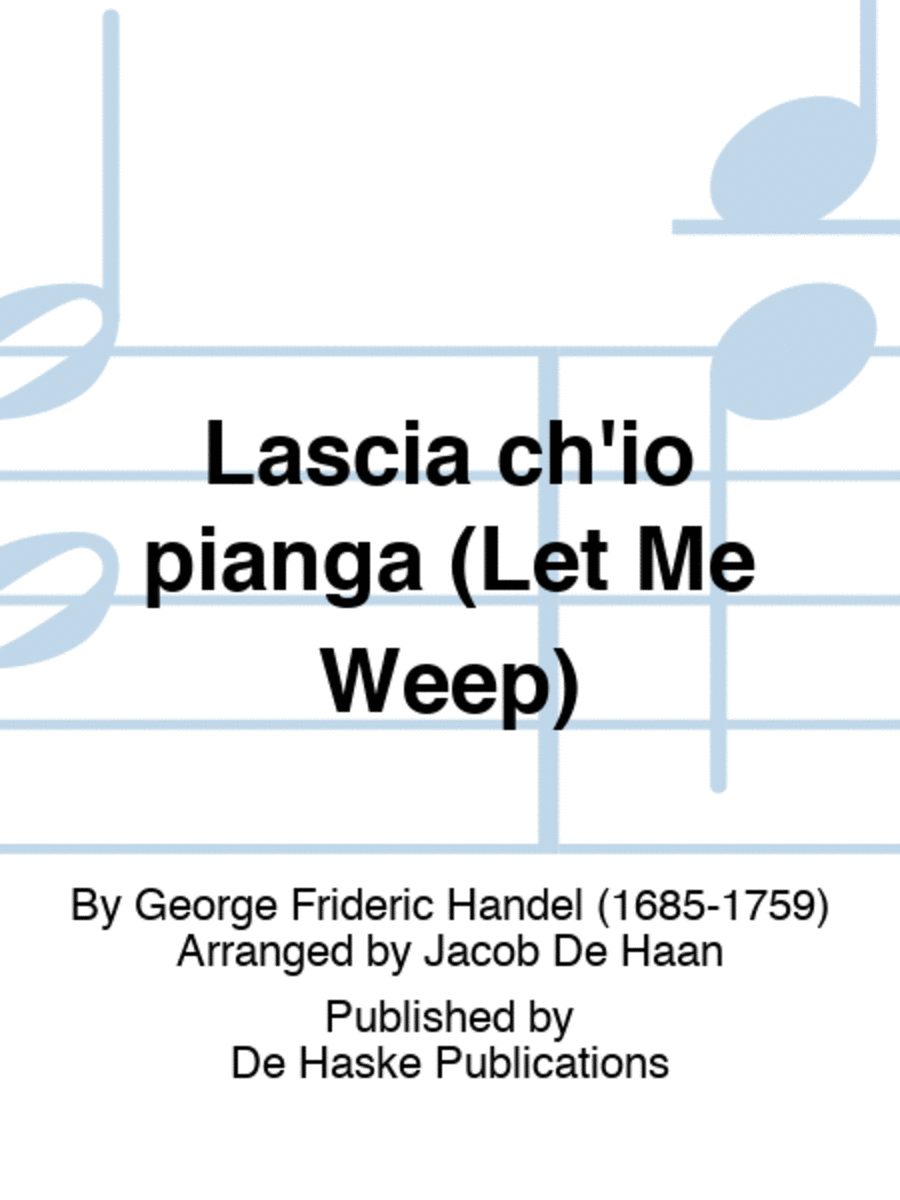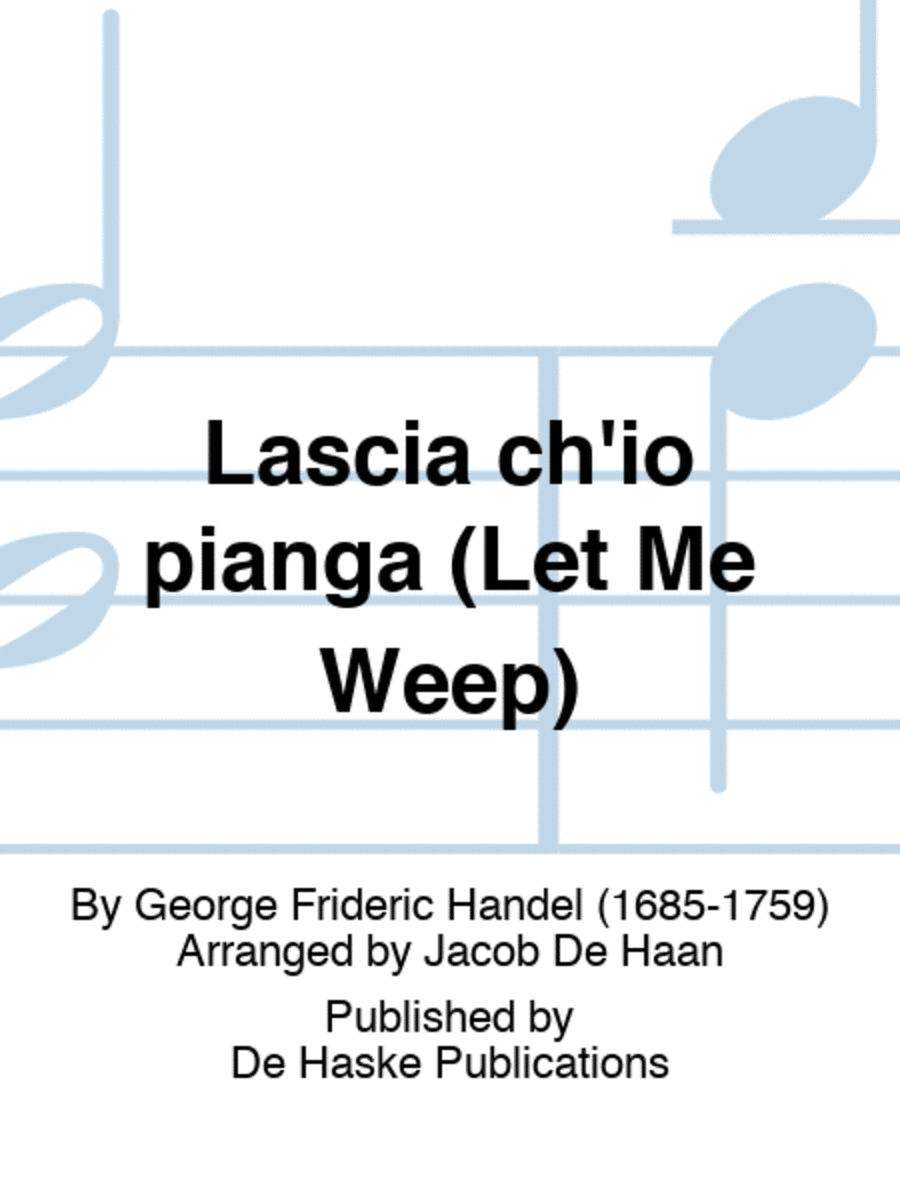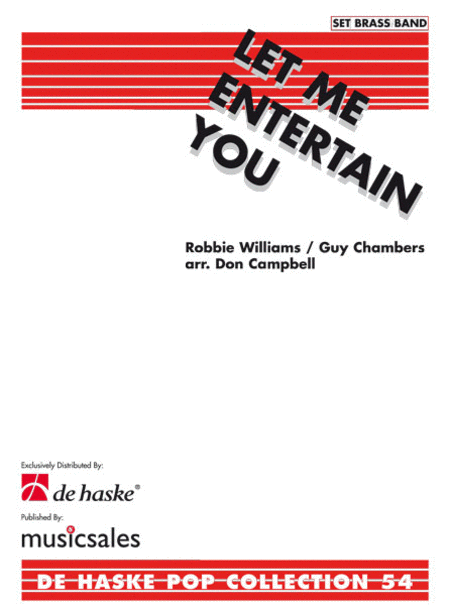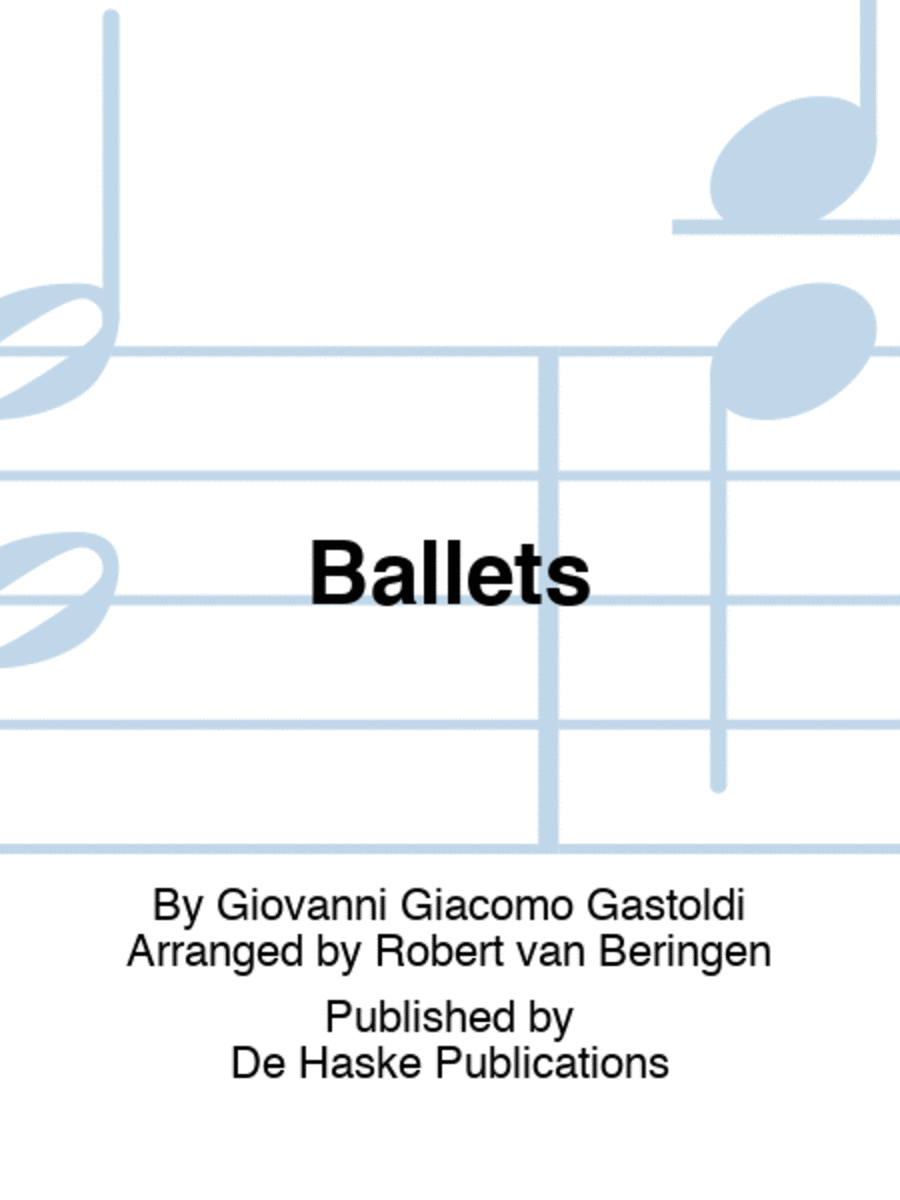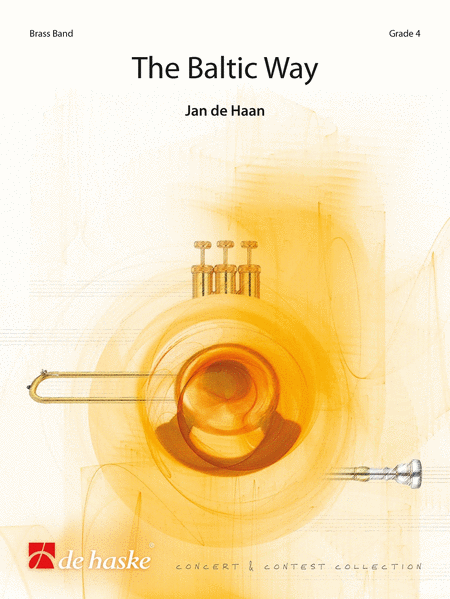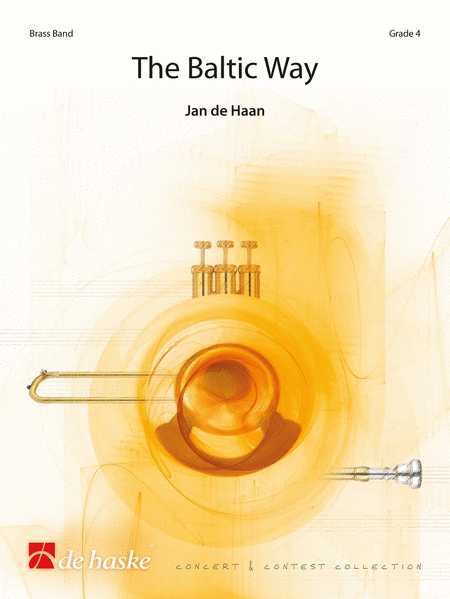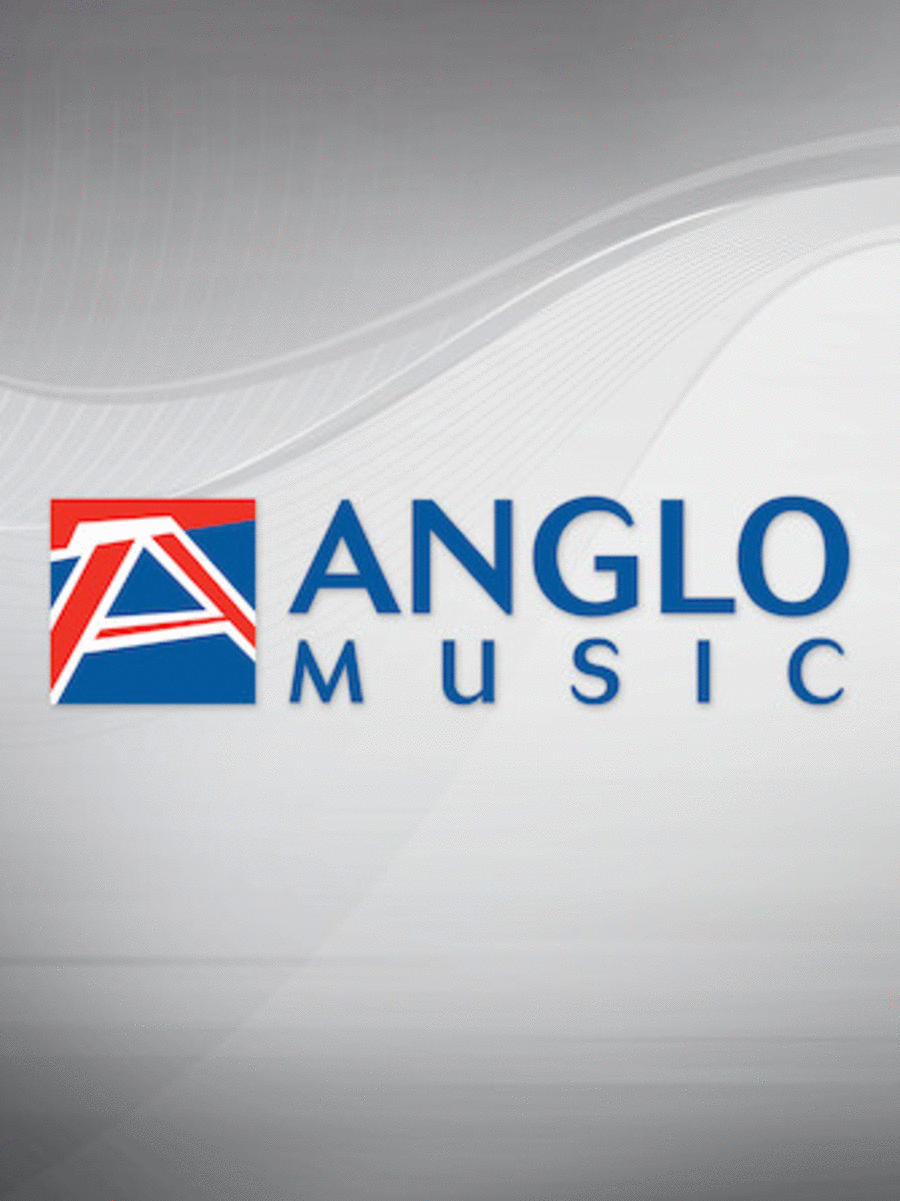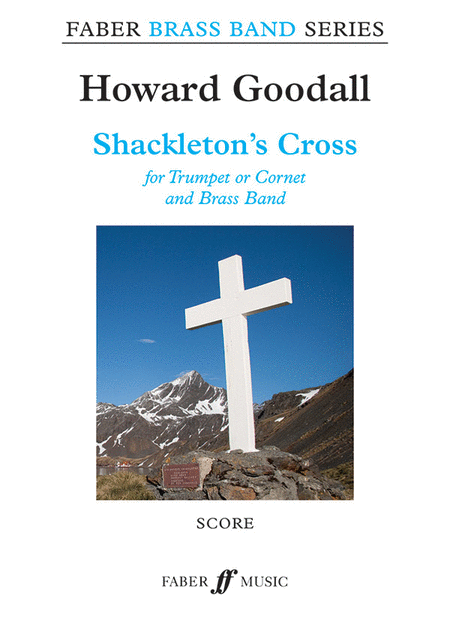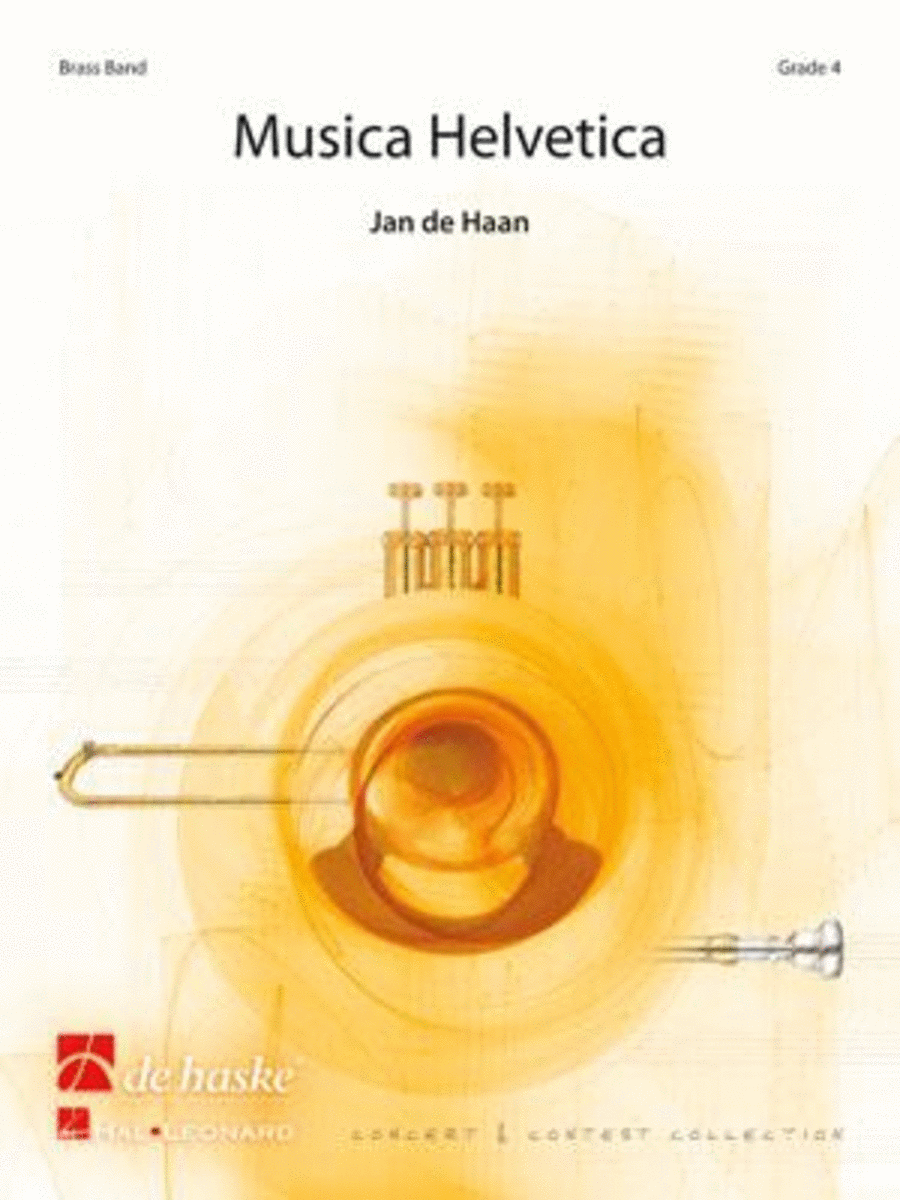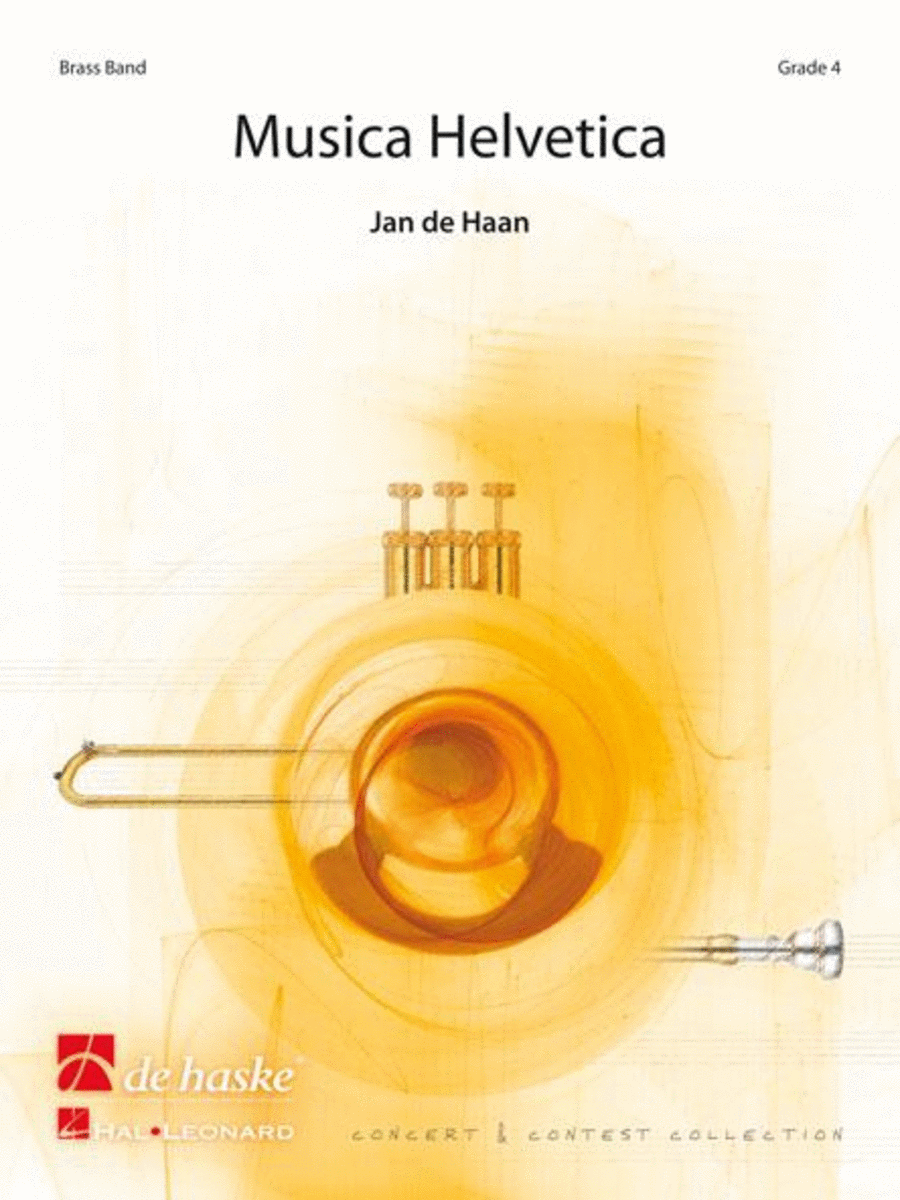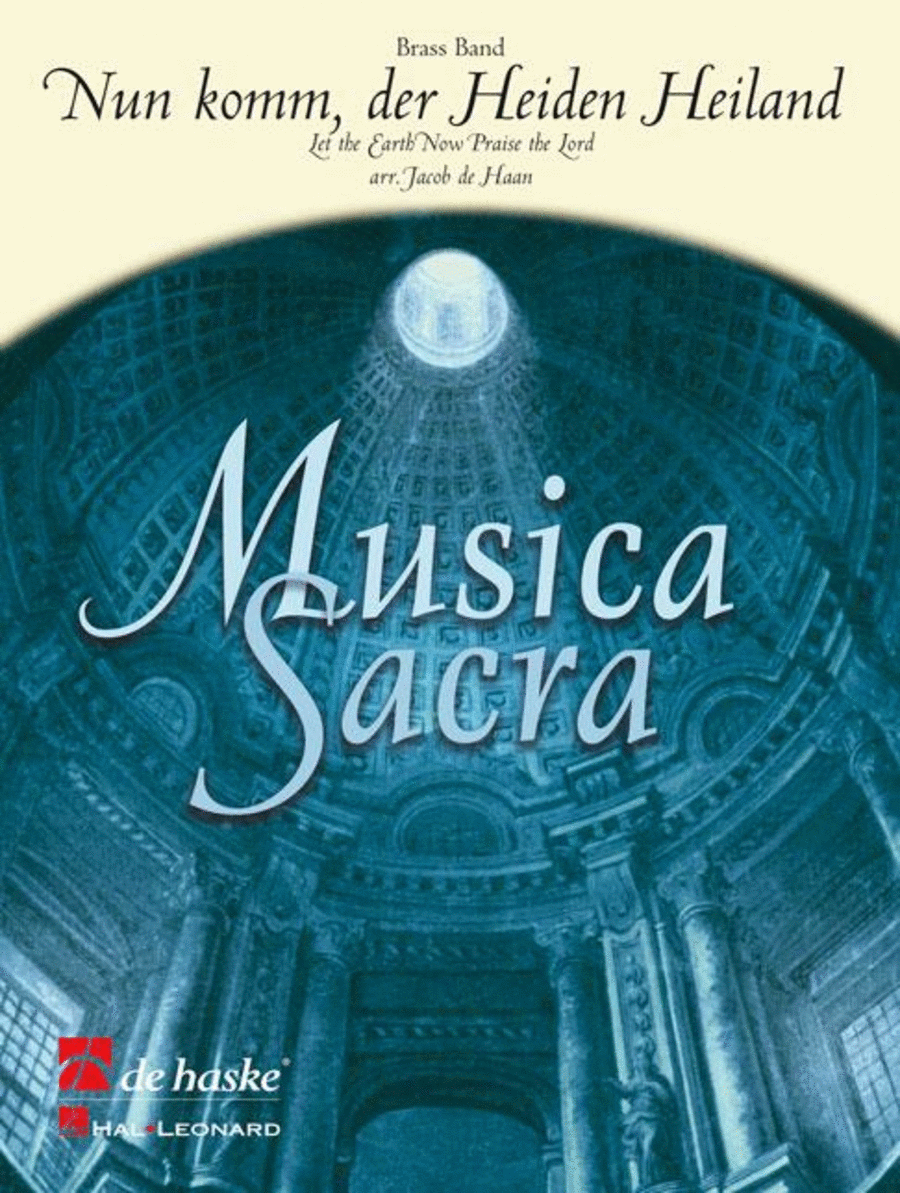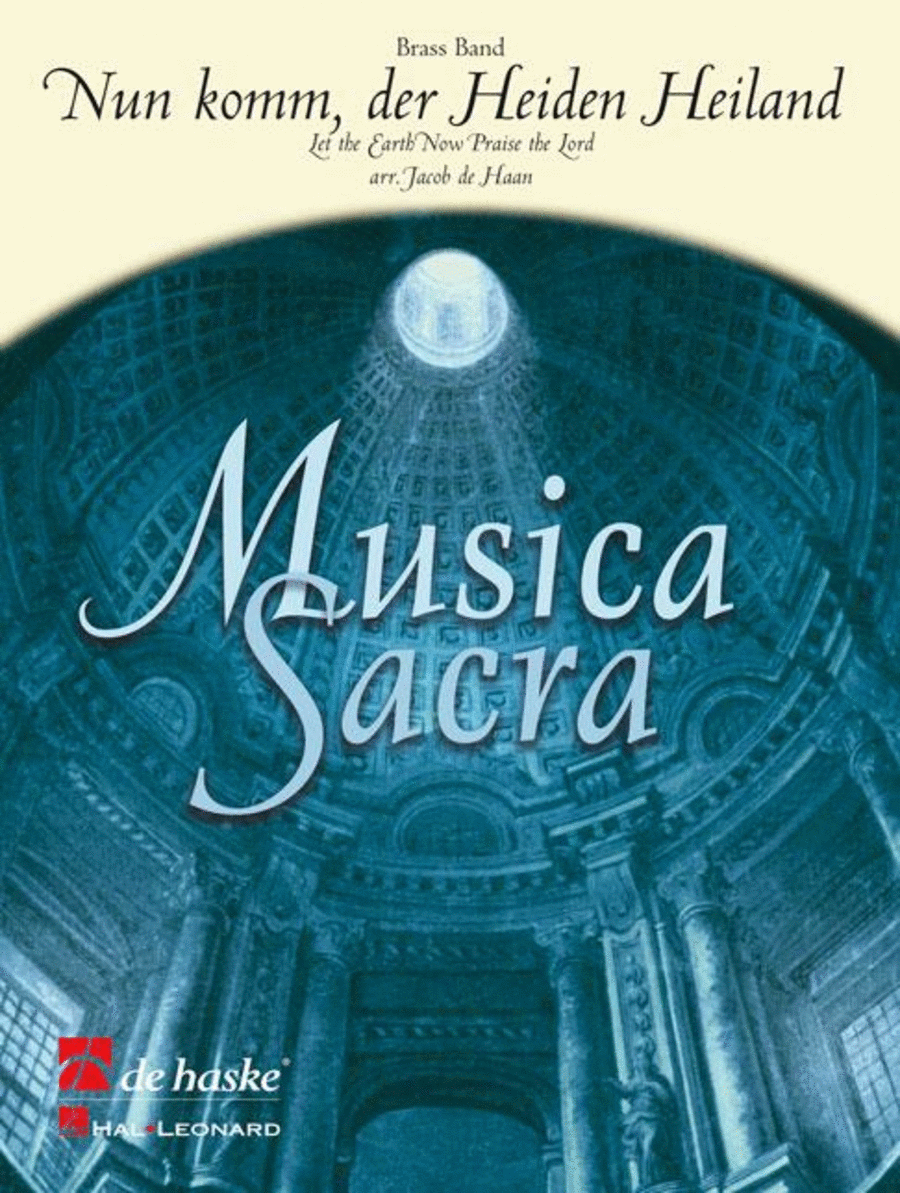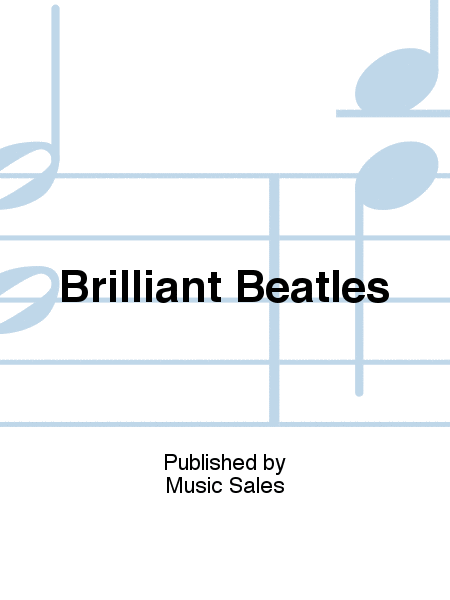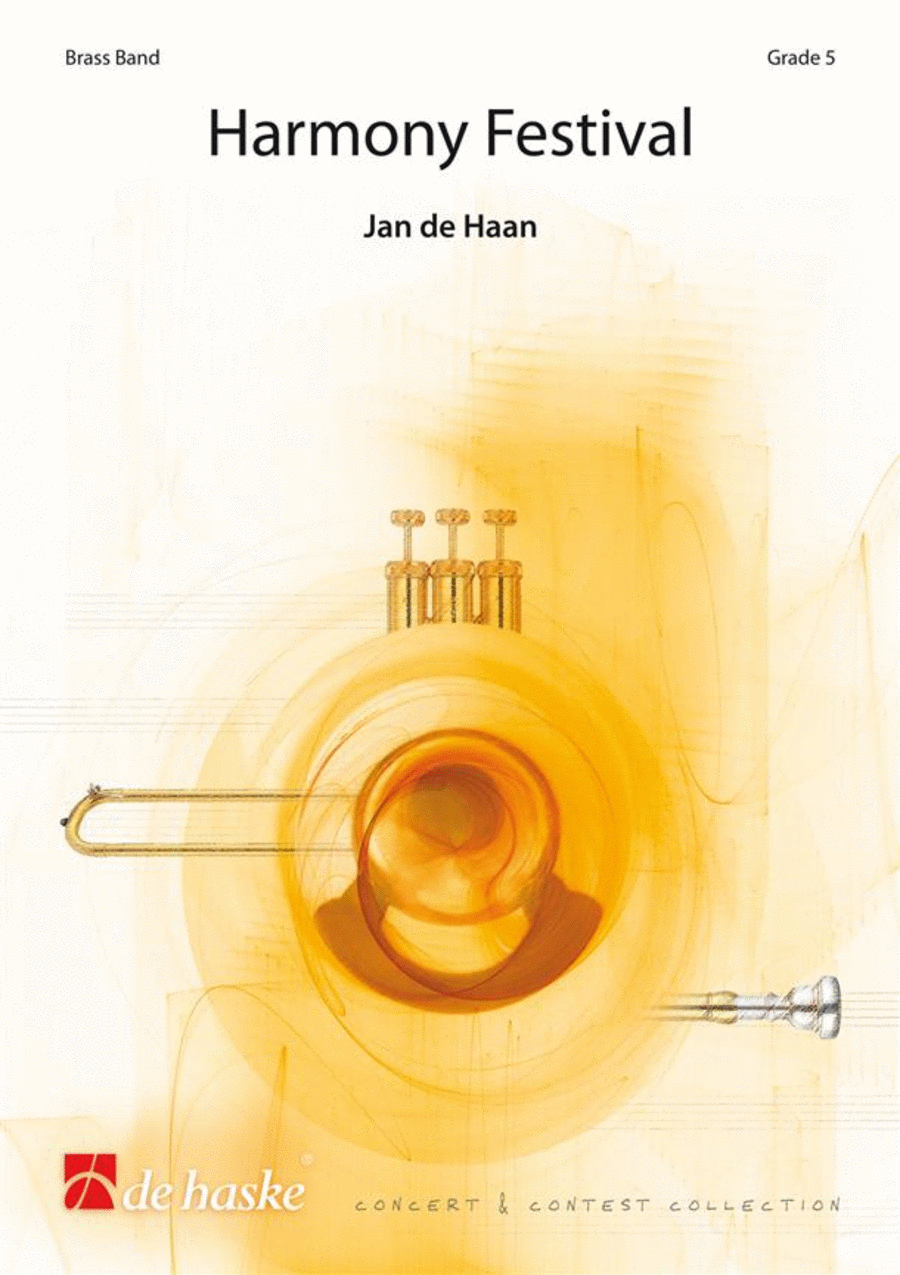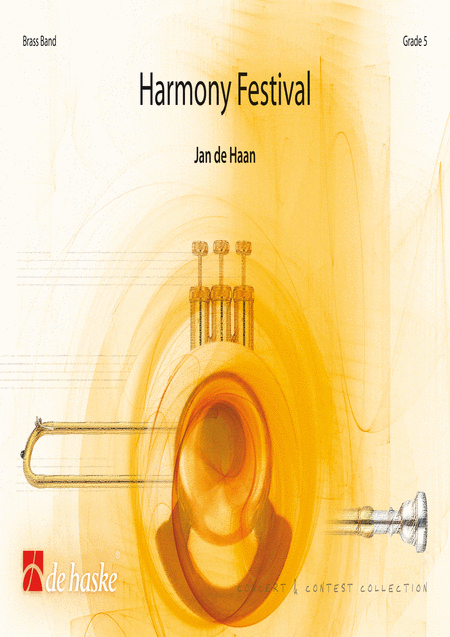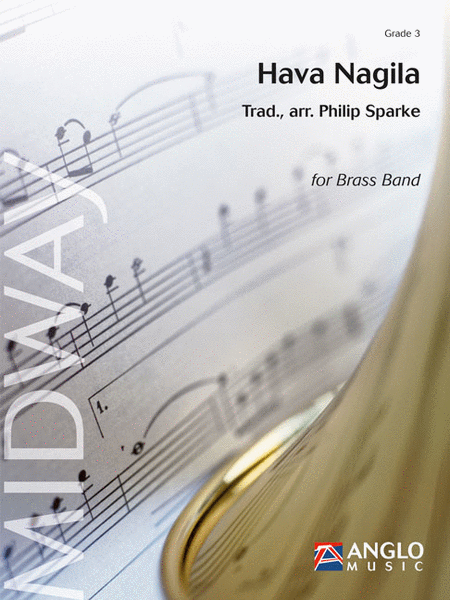|
| Lascia ch'io pianga (Let Me Weep)
Ensemble de cuivres [Conducteur et Parties séparées] - Facile
De Haske Publications
Brass Band - Grade 2 SKU: BT.DHP-1043545-030 From the opera Rinaldo va...(+)
Brass Band - Grade 2
SKU:
BT.DHP-1043545-030
From the opera Rinaldo
van Georg Friedrich
Händel. Composed
by George Frideric
Handel. Arranged by Jacob
De Haan. Your Favorite
Classics. Set (Score &
Parts). Composed 2004. De
Haske Publications #DHP
1043545-030. Published by
De Haske Publications
(BT.DHP-1043545-030).
Let Me Weep
(‘Lascia
ch’io
pianga’) is an
aria from Handel’s
opera
‘Rinaldo’.
According to reports he
composed the music for
the complete opera in
just 14 days, using many
melodies from earlier
works. The melody of this
wonderful aria is known
all over the world and
this arrangement by Jacob
de Haan retains all the
passion of the original.
Lascia
ch’io pianga (Let
Me Weep) is een aria
uit de opera
Rinaldo. Aaron
Hill schreef het
scenario, waarna Giacomo
Rossi de poëtische
teksten schreef. Georg
Friedrich Händel
voorzag deze later van
muziek. Hij zou demuziek
in veertien dagen hebben
gecomponeerd en veel
melodieën uit eerdere
werken hebben gebruikt.
In 1711 werd
Rinaldo voor het
eerst uitgevoerd. De
melodie van deze
prachtige aria is
wereldwijd bekend en komt
uitstekendtot haar recht
in dit arrangement van
Jacob de
Haan.
Let Me
Weep - im Original
Laschia ch’io
pianga - stammt aus
der Oper Rinaldo,
deren Musik Georg
Friedrich Händel
angeblich in weniger als
vierzehn Tagen
geschrieben hat! Er
verwendete für diese
märchenhafte Oper
viele Melodien aus
älteren Werken. Die
Melodie dieser
prächtigen Arie ist
weltweit bekannt und
beliebt - so ist mit
Jacob de Haans
hervorragender
Bearbeitung für Brass
Band ein Publikumserfolg
garantiert!
Lascia
ch’io pianga
est un air extrait de
Rinaldo, premier
opéra londonien de
Georg Friedrich Haendel
sur un livret de Giacomo
Rossi d’après
un scénario
d’Aaron Hill.
Quinze jours de travail
suffirent Haendel pour
achever la partition. Le
résultat est en
réalité une vaste
adaptation de plusieurs
œuvres
antérieures.
Rinaldo a
été créé
Londres en 1711. Les
décors féeriques et
chevaleresques étaient
éblouissants pour
l’époque, et
c’est sans doute
pour cela que
l’œuvre fut
plébiscitée par le
public.Dans le
merveilleux jardin du
palais enchanté
d’Armide
(l’alliée
d’Argante, le
rival de Rinaldo),
Almirène (la promise
de Rinaldo) pleure sa
captivité dansson air
Lascia ch’io
pianga, l’un
des plus beaux
qu’Haendel ait
écrits. Cette sublime
mélodie, célèbre
dans le monde entier, a
été arrangée
avec finesse et justesse
par Jacob de Haan. $78.95 - Voir plus => AcheterDélais: 2 to 3 weeks | | | |
| Lascia ch'io pianga (Let Me Weep)
Ensemble de cuivres [Conducteur] - Facile
De Haske Publications
Brass Band - Grade 2 SKU: BT.DHP-1043545-130 From the opera Rinaldo va...(+)
Brass Band - Grade 2
SKU:
BT.DHP-1043545-130
From the opera Rinaldo
van Georg Friedrich
Händel. Composed
by George Frideric
Handel. Arranged by Jacob
De Haan. Your Favorite
Classics. Score Only.
Composed 2004. De Haske
Publications #DHP
1043545-130. Published by
De Haske Publications
(BT.DHP-1043545-130).
Let Me Weep
(‘Lascia
ch’io
pianga’) is an
aria from Handel’s
opera
‘Rinaldo’.
According to reports he
composed the music for
the complete opera in
just 14 days, using many
melodies from earlier
works. The melody of this
wonderful aria is known
all over the world and
this arrangement by Jacob
de Haan retains all the
passion of the original.
Lascia
ch’io pianga (Let
Me Weep) is een aria
uit de opera
Rinaldo. Aaron
Hill schreef het
scenario, waarna Giacomo
Rossi de poëtische
teksten schreef. Georg
Friedrich Händel
voorzag deze later van
muziek. Hij zou demuziek
in veertien dagen hebben
gecomponeerd en veel
melodieën uit eerdere
werken hebben gebruikt.
In 1711 werd
Rinaldo voor het
eerst uitgevoerd. De
melodie van deze
prachtige aria is
wereldwijd bekend en komt
uitstekendtot haar recht
in dit arrangement van
Jacob de
Haan.
Let Me
Weep - im Original
Laschia ch’io
pianga - stammt aus
der Oper Rinaldo,
deren Musik Georg
Friedrich Händel
angeblich in weniger als
vierzehn Tagen
geschrieben hat! Er
verwendete für diese
märchenhafte Oper
viele Melodien aus
älteren Werken. Die
Melodie dieser
prächtigen Arie ist
weltweit bekannt und
beliebt - so ist mit
Jacob de Haans
hervorragender
Bearbeitung für Brass
Band ein Publikumserfolg
garantiert!
Lascia
ch’io pianga
est un air extrait de
Rinaldo, premier
opéra londonien de
Georg Friedrich Haendel
sur un livret de Giacomo
Rossi d’après
un scénario
d’Aaron Hill.
Quinze jours de travail
suffirent Haendel pour
achever la partition. Le
résultat est en
réalité une vaste
adaptation de plusieurs
œuvres
antérieures.
Rinaldo a
été créé
Londres en 1711. Les
décors féeriques et
chevaleresques étaient
éblouissants pour
l’époque, et
c’est sans doute
pour cela que
l’œuvre fut
plébiscitée par le
public.Dans le
merveilleux jardin du
palais enchanté
d’Armide
(l’alliée
d’Argante, le
rival de Rinaldo),
Almirène (la promise
de Rinaldo) pleure sa
captivité dansson air
Lascia ch’io
pianga, l’un
des plus beaux
qu’Haendel ait
écrits. Cette sublime
mélodie, célèbre
dans le monde entier, a
été arrangée
avec finesse et justesse
par Jacob de Haan. $19.95 - Voir plus => AcheterDélais: 2 to 3 weeks | | | |
| Let's Celebrate
Ensemble de cuivres [Conducteur et Parties séparées] - Débutant
Gobelin Music Publications
Brass Band - Grade 1.5 SKU: BT.GOB-000739-030 Composed by Dagmar Kildevan...(+)
Brass Band - Grade 1.5
SKU:
BT.GOB-000739-030
Composed by Dagmar
Kildevann. Set (Score &
Parts). 64 pages. Gobelin
Music Publications #GOB
000739-030. Published by
Gobelin Music
Publications
(BT.GOB-000739-030).
Is there
something to be
celebrated? Then let's
play 'Let's Celebrate'!
This four-part suite has
been based on two
birthday songs: the
world-famous 'Happy
Birthday to you' (which
is also sung in many
other languages), and the
Dutch song 'Lang zal
hij/zij leven'. The
Fanfare opens in grand
style with the motif of
'Lang zal hij leven' and
is followed by a cheerful
March in which the motifs
of both songs can be
heard. The third part,
Song, forms a moment of
contemplation, and the
birthday presents are
unwrapped by the
percussion section in the
fourth part, Surprise
Party. The yell may be
adapted to the occasion.
(the sleigh bells caused
the composer to note down
this somewhat peculiar
yell). Of course
everybody is expected to
join in.
Valt er
wat te vieren? dan spelen
we ‘Let’s
Celebrate’! Deze vier
delige suite is gebaseerd
op twee
verjaardagsliedjes. het
wereldbekende (en in vele
talen gezongen) ‘Happy
Birthday to you’ , en
het Nederlandse ‘Lang
zal hij/zijleven’. De
Fanfare opent groots met
het ‘Lang zal hij
leven’-motief, gevolgd
door een vrolijke March
waarin beide liederen
zijn verwerkt. Het derde
deel, Song, vormt het
moment van bezinning en
de pakjes worden in het
vierde deel,Surprise
Party, uitgepakt door het
slagwerk. De yell kan
aangepast worden aan de
gelegenheid. (de
sleighbells waren de
aanleiding voor de
componist om deze wat
vreemde yell te noteren).
Het is natuurlijk wel de
bedoeling datiedereen
meedoet. $98.95 - Voir plus => AcheterDélais: 2 to 3 weeks | | | |
| Let's Celebrate
Ensemble de cuivres [Conducteur] - Débutant
Gobelin Music Publications
Brass Band - Grade 1.5 SKU: BT.GOB-000739-130 Composed by Dagmar Kildevan...(+)
Brass Band - Grade 1.5
SKU:
BT.GOB-000739-130
Composed by Dagmar
Kildevann. Score Only. 40
pages. Gobelin Music
Publications #GOB
000739-130. Published by
Gobelin Music
Publications
(BT.GOB-000739-130).
Is there
something to be
celebrated? Then let's
play 'Let's Celebrate'!
This four-part suite has
been based on two
birthday songs: the
world-famous 'Happy
Birthday to you' (which
is also sung in many
other languages), and the
Dutch song 'Lang zal
hij/zij leven'. The
Fanfare opens in grand
style with the motif of
'Lang zal hij leven' and
is followed by a cheerful
March in which the motifs
of both songs can be
heard. The third part,
Song, forms a moment of
contemplation, and the
birthday presents are
unwrapped by the
percussion section in the
fourth part, Surprise
Party. The yell may be
adapted to the occasion.
(the sleigh bells caused
the composer to note down
this somewhat peculiar
yell). Of course
everybody is expected to
join in.
Valt er
wat te vieren? dan spelen
we ‘Let’s
Celebrate’! Deze vier
delige suite is gebaseerd
op twee
verjaardagsliedjes. het
wereldbekende (en in vele
talen gezongen) ‘Happy
Birthday to you’ , en
het Nederlandse ‘Lang
zal hij/zijleven’. De
Fanfare opent groots met
het ‘Lang zal hij
leven’-motief, gevolgd
door een vrolijke March
waarin beide liederen
zijn verwerkt. Het derde
deel, Song, vormt het
moment van bezinning en
de pakjes worden in het
vierde deel,Surprise
Party, uitgepakt door het
slagwerk. De yell kan
aangepast worden aan de
gelegenheid. (de
sleighbells waren de
aanleiding voor de
componist om deze wat
vreemde yell te noteren).
Het is natuurlijk wel de
bedoeling datiedereen
meedoet. $23.95 - Voir plus => AcheterDélais: 4 to 6 weeks | | | |
| Let Me Entertain You
Ensemble de cuivres [Conducteur] - Facile
Music Sales
Brass Band - Grade 3 SKU: BT.1023192-130-MS A Robbie Williams Medley(+)
Brass Band - Grade 3
SKU:
BT.1023192-130-MS
A Robbie Williams
Medley. Arranged by
Don Campbell. De Haske
Pop Collection. Pop &
Rock. Score Only.
Composed 2002. Music
Sales #1023192-130 MS.
Published by Music Sales
(BT.1023192-130-MS).
This is a
must-play item for any
light concert programme.
Robbie Williams is
currently considered to
be the king of pop, with
his massive hit
Angels being voted
the number one song in
many charts of all time
greatest pop songs. He
appeals to an extremely
diverse audience ensuring
every person at your
concert will leave
singing the songs from
this superb work.
De nummers van de
veelzijdige Engelse
zanger en entertainer
Robbie Williams zijn al
jarenlang telkens weer te
vinden in hitparades over
de hele wereld. Deze
medley, door Don Campbell
op een vakkundige manier
gearrangeerd, bevat
desongs Supreme,
The Road to
Mandalay,
Angels en Let
Me Entertain You. Een
feest om te spelen en om
naar te
luisteren!
Die
Lieder des vielseitigen
Sänger und
Entertainers Robbie
Williams stürmen seit
Jahren immer wieder die
Hitparaden und begeistern
ein breites Publikum. Mit
diesem Medley aus vieren
seiner größten Pop-
Erfolge, gekonnt für
Brass Band arrangiert von
Don Campbell, werden auch
Sie Ihr Publikum für
sich gewinnen!
Célèbre
tant pour ses chansons
que pour son
excentricité, Robbie
Williams collectionne les
succès et les disques
en platine. Cet
arrangement de Don
Campbell rassemble quatre
des plus grands tubes de
cette star internationale
: Supreme, Road to
Mandalay, Angels et
Let Me Entertain
You.
The
songs by the versatile
singer and entertainer
Robbie Williams, high in
the pop charts for a
number of years, are
popular with an extremely
diverse audience. With
this medley of four of
his greatest hits you
will certainly bring
great pleasure to all
members of your
audience! $29.95 - Voir plus => AcheterDélais: 2 to 3 weeks | | | |
| Ballets
Ensemble de cuivres [Conducteur et Parties séparées] - Facile
De Haske Publications
Brass Band - early intermediate SKU: BT.DHP-1094725-030 From Balletti ...(+)
Brass Band - early
intermediate SKU:
BT.DHP-1094725-030
From Balletti a cinque
voci. Composed by
Giovanni Giacomo
Gastoldi. Arranged by
Robert van Beringen.
Flexible 5 Series.
Concert Piece. Set (Score
& Parts). Composed 2009.
De Haske Publications
#DHP 1094725-030.
Published by De Haske
Publications
(BT.DHP-1094725-030).
9x12 inches.
English-German-French-Dut
ch. During the
second half of the 16th
century, Giovanni Giacomo
Gastoldi composed almost
entirely sacred works,
however it was with his
Balletti, not
published until 1591 and
1594, that he gained fame
and recognition. The
homophonic structure and
simple melodies conveyed
a charming sense of
naivety that became so
popular during this
period. Robert van
Beringen has arranged
Amor Vittorioso, La
Sirena,
L’Innamorato and
L’ardito with
five part flexible
instrumentation.
G
iovanni Giacomo Gastoldi
schrieb in der zweiten
Hälfte des 16.
Jahrhunderts vorwiegend
geistliche Musik,
berühmt wurde er aber
schon zu Lebzeiten durch
seine Balletti,
die er 1591 und 1594
veröffentlichte. Die
Tänze waren mit ihren
homophonen Strukturen und
einfachen Harmonien von
einer reizvollen
Naivität, die so gut
ankam, dass sie schon
damals in zehn Auflagen
im In- und Ausland
gedruckt wurden. Robert
van Beringen bearbeitete
die Sätze Amor
Vittorioso, La Sirena,
L’Innamorato und
L’ardito
für eine
fünfstimmig variable
Besetzung.
Il
compositore e cantore
Giovanni Giacomo Gastoldi
è entrato nella storia
grazie alla raccolta di
Balletti a cinque
voci (Venezia, 1591) che
conobbe un successo senza
eguali. Scritte per
cinque voci e strumenti,
queste melodie ballate
divennero popolari anche
all’estero
(Germania, Inghilterra),
e influenzarono
compositori quali Claudio
Monteverdi e Thomas
Morlez. Robert van
Beringen ha arrangiato
quattro estratti (Amor
Vittorioso, La Sirena,
L’Innamorato e
L’Ardito) per
ensemble a strumentazione
variabile (quattro
voci). $72.95 - Voir plus => AcheterDélais: 2 to 3 weeks | | | |
| The Baltic Way
Ensemble de cuivres [Conducteur] - Intermédiaire
De Haske Publications
Brass Band - Grade 4 SKU: BT.DHP-1206253-130 Composed by Jan de Haan. Con...(+)
Brass Band - Grade 4
SKU:
BT.DHP-1206253-130
Composed by Jan de Haan.
Concert and Contest
Collection Brass Band en
Fanfare. Concert Piece.
Score Only. Composed
2019. 48 pages. De Haske
Publications #DHP
1206253-130. Published by
De Haske Publications
(BT.DHP-1206253-130).
English-German-French-
Dutch. In 1989, the
demonstration named the
Baltic Way also
known as the Baltic
Chain— was held in
the Baltic states of
Estonia, Latvia and
Lithuania by its citizens
in a call for
independence from the
Soviet Union. On 23rd
August 1989, some two
million participants
formed a human chain,
hand-in-hand all the way
from the Estonian capital
of Tallinn its Latvian
counterpart, Riga,
through to the Lithuanian
capital of Vilnius - six
hundred kilometres long.
It became the longest
human chain ever created
and turned out to be the
final push needed for
much sought-after
independence. This
historic event became the
source of inspiration for
this composition. The
introduction of thefirst
movement, ‘Struggle
for Independence’,
is based on a nocturne
for piano by the renowned
Lithuanian composer and
painter Mikalojus
Konstantinas iurlionis
(1875-1911), thematic
material from which has
been incorporated
throughout the whole
composition. The
melancholic beginning is
followed by a powerful
theme which reflects the
resolve of the Baltic
people. The sudden
aggressive, dissonant
chords and a dominant
and—in rhythmic
terms—contrary
bass drum announce that
the resistance is not
going smoothly. Just for
a moment, we hear the
anthem of the Soviet
Union in the lower brass,
but this is relentlessly
pushed to the background
by the rest of the band
playing the Lithuanian
national anthem,
‘Tautiška giesm
’ (Lithuania, our
homeland). The second
movement, ‘Decades
of Suffering’,
echoes life under the
Soviet Union's thumb. In
the pursuit of
independence, a peaceful
protest is planned in
which a human chain is
formed across the Baltic
states of Estonia, Latvia
and Lithuania. This
‘Chain of
Freedom’ is
depicted in the final
movement of the work.
De Baltische Weg
(The Baltic Way)
was een demonstratie van
de bevolking van de
Baltische staten die in
1989 plaatsvond als een
roep om onafhankelijkheid
van de Sovjet-Unie. Deze
historische gebeurtenis
vormde de inspiratiebron
voor deze compositie. Van
Vilnius via Riga naar
Tallinn werd een
zeshonderd kilometer
lange keten van naar
schatting twee miljoen
mensen gevormd. Op 23
augustus 1989 gaven al
die mensen elkaar de hand
en werd De Baltische Weg
de langste menselijke
keten ooit. Het bleek de
uiteindelijke opmaat tot
de zo gewenste
onafhankelijkheid. De
inleiding van het eerste
deel, ‘Struggle for
Independence’, is
gebaseerd op een nocturne
voor piano van
devooraanstaande Litouwse
componist en
kunstschilder Mikalojus
Konstantinas iurlionis
(1875-1911). Het
thematische materiaal van
deze nocturne is door de
hele compositie heen
verwerkt. Na het
melancholische begin
volgt een krachtig thema,
waarmee de strijdbaarheid
van de Baltische
bevolking wordt
uitgebeeld. De
plotselinge agressieve
dissonante akkoorden en
een dominante en ritmisch
gezien tegendraadse grote
trom laten horen dat het
verzet niet eenvoudig
verloopt. Even klinkt het
begin van het volkslied
van de Sovjet-Unie in het
lage koper, maar dat
wordt door de rest van de
band onverbiddelijk naar
de achtergrond verwezen
door het Litouwse
nationale volkslied
‘Tautiška giesm
’ (Litouwen, ons
vaderland). In deel twee,
‘Decades of
Suffering’, wordt
het leven onder het juk
van de Sovjet-Unie
verklankt. In het streven
naar onafhankelijkheid
worden plannen gemaakt om
als vreedzaam protest
tegen de onderdrukking
een menselijke keten te
vormen over de wegen van
de Baltische staten
Litouwen, Letland en
Estland. Deze
‘Chain of
Freedom’ wordt in
het laatste deel van het
werk muzikaal
weergegeven.
Der
sogenannte Baltischer Weg
(The Baltic Way)
auch unter dem Namen
Baltische Kette bekannt
war 1989 eine
Demonstration von
Bürgern in den
baltischen Staaten
Estland, Lettland und
Litauen mit dem Aufruf
zur Unabhängigkeit von
der Sowjetunion. Am 23.
August 1989 bildeten rund
zwei Millionen Teilnehmer
eine sechshundert
Kilometer lange
Menschenkette, die von
der estnischen Hauptstadt
Tallinn über das
lettische Riga bis zur
litauischen Hauptstadt
Vilnius reichte. Die
längste Menschenkette,
die jemals geschaffen
wurde, erwies sich als
der letzte Schritt, der
zur lang ersehnten
Unabhängigkeit
führte. Dieses
historische Ereignis
diente der Komposition
alsInspirationsquelle.
Die Einleitung des ersten
Satzes, Struggle for
Independence“,
basiert auf einem
Nocturne für Klavier
des bekannten litauischen
Komponisten und Malers
Mikalojus Konstantinas
iurlionis (1875 1911),
dessen thematisches
Material in der gesamten
Komposition verwendet
wird. Dem melancholischen
Anfang folgt ein
mitreißendes Thema,
das die Entschlossenheit
der baltischen
Bevölkerung
widerspiegelt. Die
plötzlichen
aggressiven, dissonanten
Akkorde und eine
dominante und rhythmisch
gegenläufige Bewegung
in der Basstrommel
kündigen an, dass der
Widerstand nicht
reibungslos verläuft.
Für einen kurzen
Moment erklingt die Hymne
der Sowjetunion in den
tiefen Blechbläsern,
aber diese wird
unerbittlich vom
restlichen Orchester in
den Hintergrund
gedrängt, welches die
litauische Nationalhymne
Tautiška giesm “
(Litauen, unser
Heimatland“)
spielt. Der zweite Satz,
Decades of
Suffering“,
spiegelt das Leben unter
dem Joch der Sowjetunion
wider. Für das Streben
nach Unabhängigkeit
war ein friedlicher
Protest geplant, bei dem
eine Menschenkette durch
die baltischen Staaten
Estland, Lettland und
Litauen gebildet wurde.
Diese Chain of
Freedom“ wird im
letzten Satz des Werkes
beschrieben.
En
1989, la manifestation
nommée « La Voie
balte » (The Baltic
Way) s’est
tenue en Estonie, en
Lettonie et en Lituanie,
les pays baltes dont les
citoyens demandaient
être indépendants
de l’Union
soviétique. Le 23 ao t
1989, quelque deux
millions de personnes se
tenant par la main ont
formé une chaîne
humaine de 600 km de long
reliant les trois
capitales Tallinn
(Estonie), Riga
(Lettonie) et Vilnius
(Lituanie). Cette
chaîne humaine, la
plus longue ce jour,
donna une impulsion
décisive au
rétablissement
d’une
indépendance vivement
souhaitée. Cet
événement
historique est devenu
source
d’inspiration pour
cette composition.
L’introduction du
premier mouvement,«
Struggle for Independence
», est fondée sur
un nocturne pour piano du
célèbre compositeur
et peintre letton
Mikalojus Konstantinas
iurlionis (1875-1911). Du
matériel thématique
emprunté ce nocturne
est parsemé travers la
présente composition.
Un début
mélancolique est suivi
d’un thème
puissant qui reflète
la détermination des
peuples baltes. La
présence soudaine
d’accords
agressifs et dissonants,
associés une grosse
caisse dont le
décalage rythmique
domine, indiquent que la
résistance rencontre
des obstacles. Nous
entendons
momentanément
l’hymne
soviétique dans les
cuivres graves, mais cet
air est inexorablement
repoussé
l’arrière-plan
par le reste de
l’orchestre
interprétant
l’hymne national
de Lettonie, «
Tautiška giesm »
(Lettonie, notre patrie).
Le deuxième mouvement,
« Decades of Suffering
», dépeint la vie
sous le joug de
l’Union
soviétique. la
recherche de
l’indépendance,
une manifestation
pacifique est
organisée sous la
forme d’une
chaîne humaine
traversant les trois pays
baltes l ’Estonie,
la Lettonie et la
Lituanie. Le dernier
mouvement de la pièce,
« Chain of Freedom
», exprime cet appel
la liberté. $30.95 - Voir plus => AcheterDélais: 2 to 3 weeks | | | |
| The Baltic Way
Ensemble de cuivres [Conducteur et Parties séparées] - Intermédiaire
De Haske Publications
Brass Band - Grade 4 SKU: BT.DHP-1206253-030 Composed by Jan de Haan. Con...(+)
Brass Band - Grade 4
SKU:
BT.DHP-1206253-030
Composed by Jan de Haan.
Concert and Contest
Collection Brass Band en
Fanfare. Concert Piece.
Set (Score & Parts).
Composed 2019. De Haske
Publications #DHP
1206253-030. Published by
De Haske Publications
(BT.DHP-1206253-030).
English-German-French-
Dutch. In 1989, the
demonstration named the
Baltic Way also
known as the Baltic
Chain— was held in
the Baltic states of
Estonia, Latvia and
Lithuania by its citizens
in a call for
independence from the
Soviet Union. On 23rd
August 1989, some two
million participants
formed a human chain,
hand-in-hand all the way
from the Estonian capital
of Tallinn its Latvian
counterpart, Riga,
through to the Lithuanian
capital of Vilnius - six
hundred kilometres long.
It became the longest
human chain ever created
and turned out to be the
final push needed for
much sought-after
independence. This
historic event became the
source of inspiration for
this composition. The
introduction of thefirst
movement, ‘Struggle
for Independence’,
is based on a nocturne
for piano by the renowned
Lithuanian composer and
painter Mikalojus
Konstantinas iurlionis
(1875-1911), thematic
material from which has
been incorporated
throughout the whole
composition. The
melancholic beginning is
followed by a powerful
theme which reflects the
resolve of the Baltic
people. The sudden
aggressive, dissonant
chords and a dominant
and—in rhythmic
terms—contrary
bass drum announce that
the resistance is not
going smoothly. Just for
a moment, we hear the
anthem of the Soviet
Union in the lower brass,
but this is relentlessly
pushed to the background
by the rest of the band
playing the Lithuanian
national anthem,
‘Tautiška giesm
’ (Lithuania, our
homeland). The second
movement, ‘Decades
of Suffering’,
echoes life under the
Soviet Union's thumb. In
the pursuit of
independence, a peaceful
protest is planned in
which a human chain is
formed across the Baltic
states of Estonia, Latvia
and Lithuania. This
‘Chain of
Freedom’ is
depicted in the final
movement of the work.
De Baltische Weg
(The Baltic Way)
was een demonstratie van
de bevolking van de
Baltische staten die in
1989 plaatsvond als een
roep om onafhankelijkheid
van de Sovjet-Unie. Deze
historische gebeurtenis
vormde de inspiratiebron
voor deze compositie. Van
Vilnius via Riga naar
Tallinn werd een
zeshonderd kilometer
lange keten van naar
schatting twee miljoen
mensen gevormd. Op 23
augustus 1989 gaven al
die mensen elkaar de hand
en werd De Baltische Weg
de langste menselijke
keten ooit. Het bleek de
uiteindelijke opmaat tot
de zo gewenste
onafhankelijkheid. De
inleiding van het eerste
deel, ‘Struggle for
Independence’, is
gebaseerd op een nocturne
voor piano van
devooraanstaande Litouwse
componist en
kunstschilder Mikalojus
Konstantinas iurlionis
(1875-1911). Het
thematische materiaal van
deze nocturne is door de
hele compositie heen
verwerkt. Na het
melancholische begin
volgt een krachtig thema,
waarmee de strijdbaarheid
van de Baltische
bevolking wordt
uitgebeeld. De
plotselinge agressieve
dissonante akkoorden en
een dominante en ritmisch
gezien tegendraadse grote
trom laten horen dat het
verzet niet eenvoudig
verloopt. Even klinkt het
begin van het volkslied
van de Sovjet-Unie in het
lage koper, maar dat
wordt door de rest van de
band onverbiddelijk naar
de achtergrond verwezen
door het Litouwse
nationale volkslied
‘Tautiška giesm
’ (Litouwen, ons
vaderland). In deel twee,
‘Decades of
Suffering’, wordt
het leven onder het juk
van de Sovjet-Unie
verklankt. In het streven
naar onafhankelijkheid
worden plannen gemaakt om
als vreedzaam protest
tegen de onderdrukking
een menselijke keten te
vormen over de wegen van
de Baltische staten
Litouwen, Letland en
Estland. Deze
‘Chain of
Freedom’ wordt in
het laatste deel van het
werk muzikaal
weergegeven.
Der
sogenannte Baltischer Weg
(The Baltic Way)
auch unter dem Namen
Baltische Kette bekannt
war 1989 eine
Demonstration von
Bürgern in den
baltischen Staaten
Estland, Lettland und
Litauen mit dem Aufruf
zur Unabhängigkeit von
der Sowjetunion. Am 23.
August 1989 bildeten rund
zwei Millionen Teilnehmer
eine sechshundert
Kilometer lange
Menschenkette, die von
der estnischen Hauptstadt
Tallinn über das
lettische Riga bis zur
litauischen Hauptstadt
Vilnius reichte. Die
längste Menschenkette,
die jemals geschaffen
wurde, erwies sich als
der letzte Schritt, der
zur lang ersehnten
Unabhängigkeit
führte. Dieses
historische Ereignis
diente der Komposition
alsInspirationsquelle.
Die Einleitung des ersten
Satzes, Struggle for
Independence“,
basiert auf einem
Nocturne für Klavier
des bekannten litauischen
Komponisten und Malers
Mikalojus Konstantinas
iurlionis (1875 1911),
dessen thematisches
Material in der gesamten
Komposition verwendet
wird. Dem melancholischen
Anfang folgt ein
mitreißendes Thema,
das die Entschlossenheit
der baltischen
Bevölkerung
widerspiegelt. Die
plötzlichen
aggressiven, dissonanten
Akkorde und eine
dominante und rhythmisch
gegenläufige Bewegung
in der Basstrommel
kündigen an, dass der
Widerstand nicht
reibungslos verläuft.
Für einen kurzen
Moment erklingt die Hymne
der Sowjetunion in den
tiefen Blechbläsern,
aber diese wird
unerbittlich vom
restlichen Orchester in
den Hintergrund
gedrängt, welches die
litauische Nationalhymne
Tautiška giesm “
(Litauen, unser
Heimatland“)
spielt. Der zweite Satz,
Decades of
Suffering“,
spiegelt das Leben unter
dem Joch der Sowjetunion
wider. Für das Streben
nach Unabhängigkeit
war ein friedlicher
Protest geplant, bei dem
eine Menschenkette durch
die baltischen Staaten
Estland, Lettland und
Litauen gebildet wurde.
Diese Chain of
Freedom“ wird im
letzten Satz des Werkes
beschrieben.
En
1989, la manifestation
nommée « La Voie
balte » (The Baltic
Way) s’est
tenue en Estonie, en
Lettonie et en Lituanie,
les pays baltes dont les
citoyens demandaient
être indépendants
de l’Union
soviétique. Le 23 ao t
1989, quelque deux
millions de personnes se
tenant par la main ont
formé une chaîne
humaine de 600 km de long
reliant les trois
capitales Tallinn
(Estonie), Riga
(Lettonie) et Vilnius
(Lituanie). Cette
chaîne humaine, la
plus longue ce jour,
donna une impulsion
décisive au
rétablissement
d’une
indépendance vivement
souhaitée. Cet
événement
historique est devenu
source
d’inspiration pour
cette composition.
L’introduction du
premier mouvement,«
Struggle for Independence
», est fondée sur
un nocturne pour piano du
célèbre compositeur
et peintre letton
Mikalojus Konstantinas
iurlionis (1875-1911). Du
matériel thématique
emprunté ce nocturne
est parsemé travers la
présente composition.
Un début
mélancolique est suivi
d’un thème
puissant qui reflète
la détermination des
peuples baltes. La
présence soudaine
d’accords
agressifs et dissonants,
associés une grosse
caisse dont le
décalage rythmique
domine, indiquent que la
résistance rencontre
des obstacles. Nous
entendons
momentanément
l’hymne
soviétique dans les
cuivres graves, mais cet
air est inexorablement
repoussé
l’arrière-plan
par le reste de
l’orchestre
interprétant
l’hymne national
de Lettonie, «
Tautiška giesm »
(Lettonie, notre patrie).
Le deuxième mouvement,
« Decades of Suffering
», dépeint la vie
sous le joug de
l’Union
soviétique. la
recherche de
l’indépendance,
une manifestation
pacifique est
organisée sous la
forme d’une
chaîne humaine
traversant les trois pays
baltes l ’Estonie,
la Lettonie et la
Lituanie. Le dernier
mouvement de la pièce,
« Chain of Freedom
», exprime cet appel
la liberté. $137.95 - Voir plus => AcheterDélais: 2 to 3 weeks | | | |
| Letter from Home
Ensemble de cuivres [Conducteur]
Anglo Music
Brass Band (Score) SKU: HL.44011258 Brass Band Score. Composed by ...(+)
Brass Band (Score)
SKU: HL.44011258
Brass Band Score.
Composed by Philip
Sparke. Anglo Music
Concert Band. Softcover.
28 pages. Duration 440
seconds. Anglo Music
Press #AMP257130.
Published by Anglo Music
Press (HL.44011258).
UPC:
884088890681. In
Letter from Home Philip
Sparke portrays the many
feelings and emotions
that a letter from home
can evoke. This intimate
works opens with a gentle
melody, which gradually
becomes more confused as
new emotions are
introduced. Finally
resignation sets in, but
asense of peace and
balance is restored with
the fi nal chorale. In
this emotional work
Philip Sparke truly
captures the highs and
lows of being away from
home. $28.00 - Voir plus => AcheterDélais: 2 to 3 weeks | | | |
| Shackleton's Cross
Ensemble de cuivres [Conducteur]
Faber Music Limited
For Trumpet or Cornet and Brass Band. Composed by Howard Goodall. Arrange...(+)
For Trumpet or Cornet
and Brass Band.
Composed by Howard
Goodall. Arranged by
Daniel Hall. 5 or More;
Brass Band; Performance
Music Ensemble; Solo
Small Ensembles. Faber
Edition: Faber Brass Band
Series. Score. Faber
Music #12-0571572057.
Published by Faber Music
(AP.12-0571572057).
$11.99 - Voir plus => AcheterDélais: 4 to 6 weeks | | | |
| Animal Kingdom
Ensemble de cuivres [Conducteur et Parties séparées] - Facile
Gobelin Music Publications
Brass Band - Grade 2 SKU: BT.GOB-000729-030 Composed by William Vean. Set...(+)
Brass Band - Grade 2
SKU:
BT.GOB-000729-030
Composed by William Vean.
Set (Score & Parts). 104
pages. Gobelin Music
Publications #GOB
000729-030. Published by
Gobelin Music
Publications
(BT.GOB-000729-030).
In this
composition William Vean
takes you on a journey
through the fascinating
and exciting world of
animals. Apart from it
being a composition
filled with special
effects, Animal Kingdom
contains many educational
elements, such as playing
inswing (triplets
feeling), chromatics,
flutter tonguing, gypsy
tuning, varying keys,
and, of course, dynamics
and articulation. The
melodic lines occur in
all four voices, as well
as in all percussion
parts, providing each
musician with
theopportunity to play a
solo or to accompany.
Highly recommended for
your youth band!
William Vean is an
educational composer. He
knows how to musically
shape the special
elements from our daily
lives. His music is
therefore veryexpressive,
containing creative
solutions to possible
problems. Special ways of
playing make his music
particularly interesting
for the winds, but the
percussion section is
also featured in his
special effects.
The world of the
animalsalways plays on
ones imagination. In
Animal Kingdom, William
Vean has portrayed a
number of animals in a
special manner:
Kevin Kangaroo - The
jumping character of this
animal can be heard in
different voices. The
swing style
alsoemphasizes the
characteristic movements
of the kangaroo. Playing
in swing style can be
practised by using
scales.
Eddy
Elephant - For some of
his smaller fellow fauna
friends this can be quite
an ordeal, but for Eduard
(Eddy for friendsand
intimates) it is his
daily walk.
Baldrick Bat - Baldrick
the Bat is a mysterious
character. This can be
heard in the fast moving
valves and keys,
accompanied by special
effects in the percussion
section.
Curtis
Camel - Curtisthe Camel
trudges across the
desert, feeling bored.
The idea that the horizon
will never change does
not affect him anymore.
He has accepted his fate.
The distinctive tones
from the gypsy scale
provide the suitable
oriental sounds.
BettyButterfly -
Butterfly Betty
elegantly, and without
worries, flutters from
flower to flower in the
garden. Her motto: Carpe
Diem (Seize the Day).
Betty is a one-day
butterfly.
Marvin
Monkey - A swing monkey
stirs up the feelings.
Evenmembers of the
orchestra will look like
real monkeys. How about
your audience?
Each part has its own
difficulties and
challenges.
Important
in the first part is
playing in swing
(triplets feeling). This
can be practised
usingscales.
In the
second part ensemble
playing and balance are
important.
In
Baldrick additional
information on the
effects that have to be
played might be useful.
New sounds are, of
course, welcome.
Curtis the Camel
introduces thegypsy
scale. Additional
explanation of the use of
the scale might be
useful. Key changes are
interesting in this part.
A slight accent on the
first beat of the bar
will add to the charm of
this part.
Marvin the
Monkey brings back the
swingrhythm that was
introduced in the first
part, alternated by a
straight part with
attention to chromatics
and articulation.
A story teller will
definitely be an asset
when performing this
composition.
Willi
am Vean neemt u mee in de
fascinerende en
verrassende wereld van
het dierenrijk.
Naast leuke speelmuziek
vol ''special effects'',
is deze compositie zeer
educatief van opzet.
Als interessant
inhoudelijke zaken
komenonder andere aan de
orde - het in swing
spelen (triolen feeling),
chromatiek, flatterzunge,
zigeunertoonsoort,
afwisselende maatsoorten
en natuurlijk dynamiek en
articulatie.
Tevens
lopen de melodielijnen
zowel door alle 4
destemmen als alle
percussie partijen, zodat
iedere muzikant de
gelegenheid krijgt om te
soleren dan wel te
begeleiden.
Een
aanrader voor uw
jeugdorkest!
De
dierenwereld spreekt
muzikaal gezien altijd
tot de
verbeelding.William Vean
heeft op bijzondere wijze
een aantal dieren
neergezet.
De
componist weet op een
bijzondere wijze
elementen uit het
dagelijkse leven muzikaal
vorm te geven. Zijn
muziek is daarom erg
beeldend, de problemen
aanwijsbaarmaar de
oplossingen zijn
creatief.
Voor
blazers bijzonder
interessant door de
bijzondere speelmanieren
maar het slagwerk is ook
bedeeld met een aantal
'special effects'.
Kevin Kangaroo -
Het springerige
karakterwordt door
verschillende stemmen
neergezet. De swingende
speelstijl benadrukt de
karakteristieke
bewegingen van de
kangoeroe. Let op de
specifieke swingstijl.
Heel goed te oefenen met
toonladders.
Eddy
Elephant - Voor
sommigekleinere
faunagenoten elke keer
weer een beproeving maar
voor Eduard (Eddy voor
vrienden en intimi) is
dit zijn dagelijkse
wandelingetje. Giro
224544 t.b.v. de geleden
schade.
Baldrick
Bat - De vleermuis
Baldrick is eenmysterieus
type. Dat mysterieuze
aspect wordt auditief
weergegeven door het snel
indrukken van ventielen
en kleppen, ondersteund
door
slagwerkeffecten.
Curtis Camel - De kameel
Curtis hobbelt verveeld
door de woestijn. $98.95 - Voir plus => AcheterDélais: 2 to 3 weeks | | | |
| Animal Kingdom
Ensemble de cuivres [Conducteur] - Facile
Gobelin Music Publications
Brass Band - Grade 2 SKU: BT.GOB-000729-130 Composed by William Vean. Sco...(+)
Brass Band - Grade 2
SKU:
BT.GOB-000729-130
Composed by William Vean.
Score Only. 24 pages.
Gobelin Music
Publications #GOB
000729-130. Published by
Gobelin Music
Publications
(BT.GOB-000729-130).
In this
composition William Vean
takes you on a journey
through the fascinating
and exciting world of
animals. Apart from it
being a composition
filled with special
effects, Animal Kingdom
contains many educational
elements, such as playing
inswing (triplets
feeling), chromatics,
flutter tonguing, gypsy
tuning, varying keys,
and, of course, dynamics
and articulation. The
melodic lines occur in
all four voices, as well
as in all percussion
parts, providing each
musician with
theopportunity to play a
solo or to accompany.
Highly recommended for
your youth band!
William Vean is an
educational composer. He
knows how to musically
shape the special
elements from our daily
lives. His music is
therefore veryexpressive,
containing creative
solutions to possible
problems. Special ways of
playing make his music
particularly interesting
for the winds, but the
percussion section is
also featured in his
special effects.
The world of the
animalsalways plays on
ones imagination. In
Animal Kingdom, William
Vean has portrayed a
number of animals in a
special manner:
Kevin Kangaroo - The
jumping character of this
animal can be heard in
different voices. The
swing style
alsoemphasizes the
characteristic movements
of the kangaroo. Playing
in swing style can be
practised by using
scales.
Eddy
Elephant - For some of
his smaller fellow fauna
friends this can be quite
an ordeal, but for Eduard
(Eddy for friendsand
intimates) it is his
daily walk.
Baldrick Bat - Baldrick
the Bat is a mysterious
character. This can be
heard in the fast moving
valves and keys,
accompanied by special
effects in the percussion
section.
Curtis
Camel - Curtisthe Camel
trudges across the
desert, feeling bored.
The idea that the horizon
will never change does
not affect him anymore.
He has accepted his fate.
The distinctive tones
from the gypsy scale
provide the suitable
oriental sounds.
BettyButterfly -
Butterfly Betty
elegantly, and without
worries, flutters from
flower to flower in the
garden. Her motto: Carpe
Diem (Seize the Day).
Betty is a one-day
butterfly.
Marvin
Monkey - A swing monkey
stirs up the feelings.
Evenmembers of the
orchestra will look like
real monkeys. How about
your audience?
Each part has its own
difficulties and
challenges.
Important
in the first part is
playing in swing
(triplets feeling). This
can be practised
usingscales.
In the
second part ensemble
playing and balance are
important.
In
Baldrick additional
information on the
effects that have to be
played might be useful.
New sounds are, of
course, welcome.
Curtis the Camel
introduces thegypsy
scale. Additional
explanation of the use of
the scale might be
useful. Key changes are
interesting in this part.
A slight accent on the
first beat of the bar
will add to the charm of
this part.
Marvin the
Monkey brings back the
swingrhythm that was
introduced in the first
part, alternated by a
straight part with
attention to chromatics
and articulation.
A story teller will
definitely be an asset
when performing this
composition.
Willi
am Vean neemt u mee in de
fascinerende en
verrassende wereld van
het dierenrijk.
Naast leuke speelmuziek
vol ''special effects'',
is deze compositie zeer
educatief van opzet.
Als interessant
inhoudelijke zaken
komenonder andere aan de
orde - het in swing
spelen (triolen feeling),
chromatiek, flatterzunge,
zigeunertoonsoort,
afwisselende maatsoorten
en natuurlijk dynamiek en
articulatie.
Tevens
lopen de melodielijnen
zowel door alle 4
destemmen als alle
percussie partijen, zodat
iedere muzikant de
gelegenheid krijgt om te
soleren dan wel te
begeleiden.
Een
aanrader voor uw
jeugdorkest!
De
dierenwereld spreekt
muzikaal gezien altijd
tot de
verbeelding.William Vean
heeft op bijzondere wijze
een aantal dieren
neergezet.
De
componist weet op een
bijzondere wijze
elementen uit het
dagelijkse leven muzikaal
vorm te geven. Zijn
muziek is daarom erg
beeldend, de problemen
aanwijsbaarmaar de
oplossingen zijn
creatief.
Voor
blazers bijzonder
interessant door de
bijzondere speelmanieren
maar het slagwerk is ook
bedeeld met een aantal
'special effects'.
Kevin Kangaroo -
Het springerige
karakterwordt door
verschillende stemmen
neergezet. De swingende
speelstijl benadrukt de
karakteristieke
bewegingen van de
kangoeroe. Let op de
specifieke swingstijl.
Heel goed te oefenen met
toonladders.
Eddy
Elephant - Voor
sommigekleinere
faunagenoten elke keer
weer een beproeving maar
voor Eduard (Eddy voor
vrienden en intimi) is
dit zijn dagelijkse
wandelingetje. Giro
224544 t.b.v. de geleden
schade.
Baldrick
Bat - De vleermuis
Baldrick is eenmysterieus
type. Dat mysterieuze
aspect wordt auditief
weergegeven door het snel
indrukken van ventielen
en kleppen, ondersteund
door
slagwerkeffecten.
Curtis Camel - De kameel
Curtis hobbelt verveeld
door de woestijn. $25.95 - Voir plus => AcheterDélais: 2 to 3 weeks | | | |
| Musica Helvetica
Ensemble de cuivres [Conducteur et Parties séparées] - Intermédiaire
De Haske Publications
Brass Band - Grade 4 SKU: BT.DHP-1125266-030 Composed by Jan de Haan. Con...(+)
Brass Band - Grade 4
SKU:
BT.DHP-1125266-030
Composed by Jan de Haan.
Concert and Contest
Collection Brass Band en
Fanfare. Concert Piece.
Set (Score & Parts).
Composed 2012. De Haske
Publications #DHP
1125266-030. Published by
De Haske Publications
(BT.DHP-1125266-030).
9x12 inches.
English-German-French-Dut
ch. Every year a
competition for wind
orchestras and brass
bands takes place in
Wallberg, Switzerland.
Apart from a hymn and a
solo piece, all
orchestras also have a
compulsory piece to play.
The commission to create
a compulsory piece for
the 2012 competition fell
to Jan de Haan. The
composition is entitled
Musica Helvetica.
It takes the form of a
three-part concert work,
in which the last two
parts flow directly from
one to the other. The
first part, Musica
Prima, is a brisk
virtuoso opening with
jazz flavours woven in.
The following section,
Musica Sacra,
offers a contrast with an
extraordinarily colourful
instrumentation for the
gorgeous main theme.
Thefinal part, Musica
Alpina, is inspired
by the great variety of
scenery in Switzerland.
With its witty humour it
makes a worthy conclusion
to this beautiful
tryptich.
In het
Zwitserse Wallberg wordt
ieder jaar een concours
voor harmonieorkesten en
brassbands georganiseerd.
Naast een hymne en een
solowerk dienen alle
orkesten een verplicht
werk uit te voeren. Voor
het concours van 2012
werd eenopdracht
verstrekt aan Jan de
Haan. De compositie kreeg
Musica Helvetica
als titel mee. Het gaat
om een driedelig
concertwerk waarvan de
laatste twee delen
onafgebroken in elkaar
overgaan. Het eerste
deel, Musica
Prima,is een virtuoze
en flitsende opening met
hier en daar jazzy
invloeden. In contrast
daarmee staat het
expressieve volgende
deel, Musica
Sacra, waarin het
gedragen hoofdthema
prachtig wordt uitgewerkt
- de instrumentatieis
hier buitengewoon
kleurrijk. Het
afsluitende deel,
Musica Alpina, is
ge nspireerd op het
afwisselende landschap
van Zwitserland. Het is
grillig van structuur en
vormt een waardige
afsluiting van dit fraaie
drieluik.
Im
schweizerischen Wallberg
wird jedes Jahr ein
Wettbewerb für
Blasorchester und Brass
Bands ausgerichtet. Neben
einer Hymne und einem
Solowerk müssen alle
Orchester ein
Pfllichtstück spielen.
Vor dem Wettbewerb im
Jahr 2012 wurde der
Auftrag zu diesem
Pflichtstück an Jan de
Haan vergeben. Die
Komposition erhielt den
Titel Musica
Helvetica. Es handelt
sich dabei um ein
dreiteiliges Konzertwerk,
dessen letzten zwei Teile
direkt ineinander
übergehen. Der erste
Teil, Musica
Prima, ist eine
virtuose, flotte
Eröffnung mit
eingestreuten jazzigen
Einflüssen. Einen
Kontrast hierzu bildet
der folgende Teil,
Musica Sacra,
worin das Hauptthema
wunderschönausgearbeit
et wird - die
Instrumentierung ist hier
außergewöhnlich
farbig. Der letzte Teil,
Musica Alpina, ist
inspiriert vom
abwechslungsreichen
Landschaftsbild der
Schweiz. Mit seiner
launigen Struktur bildet
er einen würdigen
Abschluss dieses
schönen Triptychons.
Chaque année,
un concours pour
orchestres
d’harmonie et
brass bands se déroule
Wallberg, en Suisse.
Outre un hymne et une
oeuvre avec solo, tous
les orchestres doivent
interpréter une
pièce imposée. Jan
de Haan fut chargé de
composer celle-ci pour
l’édition 2012
du concours. Intitulée
Musica Helvetica,
cette composition prend
la forme d’une
pièce de concert en
trois parties, les deux
dernières se suivant
sans interruption. La
première partie,
Musica Prima, est
une ouverture rapide,
épicée
d’accents jazzy.
La suivante, Musica
Sacra, offre un
splendide contraste avec
une instrumentation
incroyablement colorée
dans le thème
principal. La dernière
partie,Musica
Alpina,
s’inspire de la
diversité des paysages
suisses. Pleine
d’humour, elle
couronne parfaitement ce
superbe triptyque. $137.95 - Voir plus => AcheterDélais: 2 to 3 weeks | | | |
| Musica Helvetica
Ensemble de cuivres [Conducteur] - Intermédiaire
De Haske Publications
Brass Band - Grade 4 SKU: BT.DHP-1125266-130 Composed by Jan de Haan. Con...(+)
Brass Band - Grade 4
SKU:
BT.DHP-1125266-130
Composed by Jan de Haan.
Concert and Contest
Collection Brass Band en
Fanfare. Concert Piece.
Score Only. Composed
2012. 47 pages. De Haske
Publications #DHP
1125266-130. Published by
De Haske Publications
(BT.DHP-1125266-130).
9x12 inches.
English-German-French-Dut
ch. Every year a
competition for wind
orchestras and brass
bands takes place in
Wallberg, Switzerland.
Apart from a hymn and a
solo piece, all
orchestras also have a
compulsory piece to play.
The commission to create
a compulsory piece for
the 2012 competition fell
to Jan de Haan. The
composition is entitled
Musica Helvetica.
It takes the form of a
three-part concert work,
in which the last two
parts flow directly from
one to the other. The
first part, Musica
Prima, is a brisk
virtuoso opening with
jazz flavours woven in.
The following section,
Musica Sacra,
offers a contrast with an
extraordinarily colourful
instrumentation for the
gorgeous main theme.
Thefinal part, Musica
Alpina, is inspired
by the great variety of
scenery in Switzerland.
With its witty humour it
makes a worthy conclusion
to this beautiful
tryptich.
In het
Zwitserse Wallberg wordt
ieder jaar een concours
voor harmonieorkesten en
brassbands georganiseerd.
Naast een hymne en een
solowerk dienen alle
orkesten een verplicht
werk uit te voeren. Voor
het concours van 2012
werd eenopdracht
verstrekt aan Jan de
Haan. De compositie kreeg
Musica Helvetica
als titel mee. Het gaat
om een driedelig
concertwerk waarvan de
laatste twee delen
onafgebroken in elkaar
overgaan. Het eerste
deel, Musica
Prima,is een virtuoze
en flitsende opening met
hier en daar jazzy
invloeden. In contrast
daarmee staat het
expressieve volgende
deel, Musica
Sacra, waarin het
gedragen hoofdthema
prachtig wordt uitgewerkt
- de instrumentatieis
hier buitengewoon
kleurrijk. Het
afsluitende deel,
Musica Alpina, is
ge nspireerd op het
afwisselende landschap
van Zwitserland. Het is
grillig van structuur en
vormt een waardige
afsluiting van dit fraaie
drieluik.
Im
schweizerischen Wallberg
wird jedes Jahr ein
Wettbewerb für
Blasorchester und Brass
Bands ausgerichtet. Neben
einer Hymne und einem
Solowerk müssen alle
Orchester ein
Pfllichtstück spielen.
Vor dem Wettbewerb im
Jahr 2012 wurde der
Auftrag zu diesem
Pflichtstück an Jan de
Haan vergeben. Die
Komposition erhielt den
Titel Musica
Helvetica. Es handelt
sich dabei um ein
dreiteiliges Konzertwerk,
dessen letzten zwei Teile
direkt ineinander
übergehen. Der erste
Teil, Musica
Prima, ist eine
virtuose, flotte
Eröffnung mit
eingestreuten jazzigen
Einflüssen. Einen
Kontrast hierzu bildet
der folgende Teil,
Musica Sacra,
worin das Hauptthema
wunderschönausgearbeit
et wird - die
Instrumentierung ist hier
außergewöhnlich
farbig. Der letzte Teil,
Musica Alpina, ist
inspiriert vom
abwechslungsreichen
Landschaftsbild der
Schweiz. Mit seiner
launigen Struktur bildet
er einen würdigen
Abschluss dieses
schönen Triptychons.
Chaque année,
un concours pour
orchestres
d’harmonie et
brass bands se déroule
Wallberg, en Suisse.
Outre un hymne et une
oeuvre avec solo, tous
les orchestres doivent
interpréter une
pièce imposée. Jan
de Haan fut chargé de
composer celle-ci pour
l’édition 2012
du concours. Intitulée
Musica Helvetica,
cette composition prend
la forme d’une
pièce de concert en
trois parties, les deux
dernières se suivant
sans interruption. La
première partie,
Musica Prima, est
une ouverture rapide,
épicée
d’accents jazzy.
La suivante, Musica
Sacra, offre un
splendide contraste avec
une instrumentation
incroyablement colorée
dans le thème
principal. La dernière
partie,Musica
Alpina,
s’inspire de la
diversité des paysages
suisses. Pleine
d’humour, elle
couronne parfaitement ce
superbe triptyque. $47.95 - Voir plus => AcheterDélais: 2 to 3 weeks | | | |
| Sumba Samba
Ensemble de cuivres [Conducteur] - Facile
Gobelin Music Publications
Brass Band - Grade 2 SKU: BT.GOB-000856-130 Composed by Ron Gilmore. Scor...(+)
Brass Band - Grade 2
SKU:
BT.GOB-000856-130
Composed by Ron Gilmore.
Score Only. Gobelin Music
Publications #GOB
000856-130. Published by
Gobelin Music
Publications
(BT.GOB-000856-130).
The Samba is a
Latin American dance,
which is mostly
associated with parties,
as a result of the fast
tempo in which it is
usually played.
‘Sumba Samba’ forms
an exception to this
rule. In order to get
this samba to swing it is
important to stick to the
tempo prescribed.
‘Sumba Samba’ starts
with a motif which will
play an important role
throughout the piece.
This motif can be heard
in the first notes of the
‘refrain’ and, as
said before, has been
used in the introduction,
as well as in the
transition after the
middle part (letter G).
Furthermore, it plays an
important role in the
middle part itself
(letter E), in which the
samba has momentarily
disappeared and
acompletely different
atmosphere has been
created. At letter H we
pick up where we left off
with the samba and swing
to the end of this
composition.
De
Samba is een
Latijns-Amerikaanse dans.
De dans wordt meestal
geassocieerd met feest,
door het vaak snelle
tempo waarin het gespeeld
wordt.
‘Sumba
Samba’ vormt hier een
uitzondering op. Om deze
samba te laten swingen is
hetbelangrijk het
voorgeschreven tempo te
handhaven.
‘Sumba
Samba’ begint met een
motief dat in de hele
compositie een
belangrijke rol speelt.
Het zijn de eerste noten
van het thema van het
‘refrein’ en wordt
zoals gezegd
gebruikttijdens de
inleiding en bij de
overgang na het
tussendeel. (letter G).
Bovendien speelt het een
belangrijke rol in het
tussendeel (letter E)
waar de samba even weg is
en een heel andere sfeer
ontstaat. Bij letter H
pakken wede samba weer op
en swingen we naar het
slot. $17.95 - Voir plus => AcheterDélais: 4 to 6 weeks | | | |
| Sumba Samba
Ensemble de cuivres [Conducteur et Parties séparées] - Facile
Gobelin Music Publications
Brass Band - Grade 2 SKU: BT.GOB-000856-030 Composed by Ron Gilmore. Set ...(+)
Brass Band - Grade 2
SKU:
BT.GOB-000856-030
Composed by Ron Gilmore.
Set (Score & Parts).
Gobelin Music
Publications #GOB
000856-030. Published by
Gobelin Music
Publications
(BT.GOB-000856-030).
The Samba is a
Latin American dance,
which is mostly
associated with parties,
as a result of the fast
tempo in which it is
usually played.
‘Sumba Samba’ forms
an exception to this
rule. In order to get
this samba to swing it is
important to stick to the
tempo prescribed.
‘Sumba Samba’ starts
with a motif which will
play an important role
throughout the piece.
This motif can be heard
in the first notes of the
‘refrain’ and, as
said before, has been
used in the introduction,
as well as in the
transition after the
middle part (letter G).
Furthermore, it plays an
important role in the
middle part itself
(letter E), in which the
samba has momentarily
disappeared and
acompletely different
atmosphere has been
created. At letter H we
pick up where we left off
with the samba and swing
to the end of this
composition.
De
Samba is een
Latijns-Amerikaanse dans.
De dans wordt meestal
geassocieerd met feest,
door het vaak snelle
tempo waarin het gespeeld
wordt.
‘Sumba
Samba’ vormt hier een
uitzondering op. Om deze
samba te laten swingen is
hetbelangrijk het
voorgeschreven tempo te
handhaven.
‘Sumba
Samba’ begint met een
motief dat in de hele
compositie een
belangrijke rol speelt.
Het zijn de eerste noten
van het thema van het
‘refrein’ en wordt
zoals gezegd
gebruikttijdens de
inleiding en bij de
overgang na het
tussendeel. (letter G).
Bovendien speelt het een
belangrijke rol in het
tussendeel (letter E)
waar de samba even weg is
en een heel andere sfeer
ontstaat. Bij letter H
pakken wede samba weer op
en swingen we naar het
slot. $72.95 - Voir plus => AcheterDélais: 2 to 3 weeks | | | |
| Fanfare La Perie
Ensemble de cuivres [Conducteur et Parties séparées] - Intermédiaire
Gobelin Music Publications
Brass Band - Grade 4 SKU: BT.GOB-000058-030 Composed by Paul Dukas. Arran...(+)
Brass Band - Grade 4
SKU:
BT.GOB-000058-030
Composed by Paul Dukas.
Arranged by Peter Wain.
Set (Score & Parts). 25
pages. Gobelin Music
Publications #GOB
000058-030. Published by
Gobelin Music
Publications
(BT.GOB-000058-030).
In 1911 the
Russian impresario
Diaghilev commisioned
Paul Dukas to compose
music for the famous
ballet fairy-tale 'La
Perie'by Jean
Coralli.
Fokine was to
make a new choreography,
so that the Russian
ballet company 'Ballet
Russes' would be able to
perform the piece in
Paris that same year.
Due to a quarrel between
Diaghilev and Dukas about
who should dance the
title-part, however, the
ballet was not performed
by the 'Ballet Russes'but
by another company in
1912.
The ballet 'La
Perie' is Dukas' last
symphonic work. In 1911
gaf de Russische
impresario Diaghilev Paul
Dukas opdracht om muziek
te componeren voor het
beroemde ballet sprookje
'La Perie' van Jean
Coralli.
Fokine was
gevraagd om een nieuwe
choreografie te maken,
zodat het Russische
balletgezelschap 'Ballet
Russes' in staat zou zijn
om het stuk in Parijs op
te voeren in datzelfde
jaar.
Door een ruzie
tussen Diaghilev en Dukas
over de vraag wie de
hoofdrol mocht dansen,
werd het ballet in 1912
echter niet uitgevoerd
door het 'Ballet Russes'
maar door een ander
gezelschap.
Het
ballet 'La Perie' is het
laatste symfonische werk
van Dukas.
Gobelin Music
Publications. $78.95 - Voir plus => AcheterDélais: 2 to 3 weeks | | | |
| Fanfare La Perie
Ensemble de cuivres [Conducteur] - Intermédiaire
Gobelin Music Publications
Brass Band - Grade 4 SKU: BT.GOB-000058-130 Composed by Paul Dukas. Arran...(+)
Brass Band - Grade 4
SKU:
BT.GOB-000058-130
Composed by Paul Dukas.
Arranged by Peter Wain.
Score Only. 9 pages.
Gobelin Music
Publications #GOB
000058-130. Published by
Gobelin Music
Publications
(BT.GOB-000058-130).
In 1911 the
Russian impresario
Diaghilev commisioned
Paul Dukas to compose
music for the famous
ballet fairy-tale 'La
Perie'by Jean
Coralli.
Fokine was to
make a new choreography,
so that the Russian
ballet company 'Ballet
Russes' would be able to
perform the piece in
Paris that same year.
Due to a quarrel between
Diaghilev and Dukas about
who should dance the
title-part, however, the
ballet was not performed
by the 'Ballet Russes'but
by another company in
1912.
The ballet 'La
Perie' is Dukas' last
symphonic work. In 1911
gaf de Russische
impresario Diaghilev Paul
Dukas opdracht om muziek
te componeren voor het
beroemde ballet sprookje
'La Perie' van Jean
Coralli.
Fokine was
gevraagd om een nieuwe
choreografie te maken,
zodat het Russische
balletgezelschap 'Ballet
Russes' in staat zou zijn
om het stuk in Parijs op
te voeren in datzelfde
jaar.
Door een ruzie
tussen Diaghilev en Dukas
over de vraag wie de
hoofdrol mocht dansen,
werd het ballet in 1912
echter niet uitgevoerd
door het 'Ballet Russes'
maar door een ander
gezelschap.
Het
ballet 'La Perie' is het
laatste symfonische werk
van Dukas.
Gobelin Music
Publications. $16.95 - Voir plus => AcheterDélais: 4 to 6 weeks | | | |
| Fantasy for Brassband and Organ
Ensemble de cuivres [Conducteur] - Intermédiaire
Gobelin Music Publications
Brass Band - Grade 4 SKU: BT.GOB-000922-130 Composed by Jan Bosveld. Scor...(+)
Brass Band - Grade 4
SKU:
BT.GOB-000922-130
Composed by Jan Bosveld.
Score Only. 24 pages.
Gobelin Music
Publications #GOB
000922-130. Published by
Gobelin Music
Publications
(BT.GOB-000922-130).
When I was
approached to compose a
work for brassband and
church organ I already
envisioned the concept I
would use. It would
indeed literally become a
work for brassband and
organ. Without the
traditional solos, the
organ would form an
addition to the brassband
orchestration as would
the brassband provide an
extra register for the
organ. In short a
homogeneous entity. The
most important reason for
doing this is quite
simple. Since this work
can only be performed in
a church and because of
the specific acoustics of
the church, the brassband
would sound in al its
tone colour like an
organ. By using certain
registers of the organ
and combining these with
the brassband a
wonderfulsound palette
can be created. The use
of complementary or
contrasting tone quality
is also possible. The
primary theme of this
composition is based on
these three methods of
“colouring”. As far
as structure is concerned
this work consists of two
parts. slow fast. It is
built on a number of
motifs in which some
behave like a consecutive
canon. In the fast
movement the primary
motif develops into a
fugue-like section. The
canon and fugato are
techniques frequently
used in classical and
contemporary organ
literature. The liberal
use of structure and
motif has lead to the
title. “Fantasy for
Brassband and Organ”.
Jan Bosveld
zegt:Toen mij gevraagd
werd een compositie te
maken voor brassband en
kerkorgel stond mij
direct een duidelijk
concept voor ogen. Het
zou inderdaad een werk
gaan worden voor
brassband en orgel in de
letterlijke zin vanhet
woord. Geen traditioneel
solowerk maar het orgel
als uitbreiding van de
brassbandbezetting en de
brassband als een extra
register van het orgel.
Kortom, een homogeen
geheel. De belangrijkste
reden hiervoor is simpel.
Het werkkan eigenlijk
alleen in een kerk worden
uitgevoerd en een
brassband, in een kerk
met zijn specifieke
akoestiek, klinkt in al
zijn kleurschakeringen
als een orgel. Door het
orgel in een bepaalde
registratie te laten
klinken kan,in combinatie
met de brassband, een
prachtige mengklank tot
stand worden gebracht.
Ook kan worden gekozen
voor een klank die
aanvullend is of
contrasterend. Deze drie
manieren van
“kleuren” is het
belangrijkste thema van
de compositie.Wat vorm
betreft bestaat het werk
uit twee delen. langzaam
snel. Het is opgebouwd
uit een aantal motieven
waarvan sommige zich
gedragen als een snel
opvolgende canon. In het
snelle deel wordt het
belangrijkste motief
uitgebreidtot een
fugato-achtig gedeelte.
De canon en het fugato
zijn technieken die zowel
in de klassieke, als de
hedendaagse
orgelliteratuur veel
worden gebruikt. Het vrij
omgaan met de vorm en de
motieven heeft geleid tot
de titel.Fantasy for
Brassband and
Organ”. $38.95 - Voir plus => AcheterDélais: 4 to 6 weeks | | | |
| Fantasy for Brassband and Organ
Ensemble de cuivres [Conducteur et Parties séparées] - Intermédiaire
Gobelin Music Publications
Brass Band - Grade 4 SKU: BT.GOB-000922-030 Composed by Jan Bosveld. Set ...(+)
Brass Band - Grade 4
SKU:
BT.GOB-000922-030
Composed by Jan Bosveld.
Set (Score & Parts). 27
pages. Gobelin Music
Publications #GOB
000922-030. Published by
Gobelin Music
Publications
(BT.GOB-000922-030).
When I was
approached to compose a
work for brassband and
church organ I already
envisioned the concept I
would use. It would
indeed literally become a
work for brassband and
organ. Without the
traditional solos, the
organ would form an
addition to the brassband
orchestration as would
the brassband provide an
extra register for the
organ. In short a
homogeneous entity. The
most important reason for
doing this is quite
simple. Since this work
can only be performed in
a church and because of
the specific acoustics of
the church, the brassband
would sound in al its
tone colour like an
organ. By using certain
registers of the organ
and combining these with
the brassband a
wonderfulsound palette
can be created. The use
of complementary or
contrasting tone quality
is also possible. The
primary theme of this
composition is based on
these three methods of
“colouring”. As far
as structure is concerned
this work consists of two
parts. slow fast. It is
built on a number of
motifs in which some
behave like a consecutive
canon. In the fast
movement the primary
motif develops into a
fugue-like section. The
canon and fugato are
techniques frequently
used in classical and
contemporary organ
literature. The liberal
use of structure and
motif has lead to the
title. “Fantasy for
Brassband and Organ”.
Jan Bosveld
zegt:Toen mij gevraagd
werd een compositie te
maken voor brassband en
kerkorgel stond mij
direct een duidelijk
concept voor ogen. Het
zou inderdaad een werk
gaan worden voor
brassband en orgel in de
letterlijke zin vanhet
woord. Geen traditioneel
solowerk maar het orgel
als uitbreiding van de
brassbandbezetting en de
brassband als een extra
register van het orgel.
Kortom, een homogeen
geheel. De belangrijkste
reden hiervoor is simpel.
Het werkkan eigenlijk
alleen in een kerk worden
uitgevoerd en een
brassband, in een kerk
met zijn specifieke
akoestiek, klinkt in al
zijn kleurschakeringen
als een orgel. Door het
orgel in een bepaalde
registratie te laten
klinken kan,in combinatie
met de brassband, een
prachtige mengklank tot
stand worden gebracht.
Ook kan worden gekozen
voor een klank die
aanvullend is of
contrasterend. Deze drie
manieren van
“kleuren” is het
belangrijkste thema van
de compositie.Wat vorm
betreft bestaat het werk
uit twee delen. langzaam
snel. Het is opgebouwd
uit een aantal motieven
waarvan sommige zich
gedragen als een snel
opvolgende canon. In het
snelle deel wordt het
belangrijkste motief
uitgebreidtot een
fugato-achtig gedeelte.
De canon en het fugato
zijn technieken die zowel
in de klassieke, als de
hedendaagse
orgelliteratuur veel
worden gebruikt. Het vrij
omgaan met de vorm en de
motieven heeft geleid tot
de titel.Fantasy for
Brassband and
Organ”. $143.95 - Voir plus => AcheterDélais: 2 to 3 weeks | | | |
| Where there's Muck
Ensemble de cuivres [Conducteur et Parties séparées] - Facile
Gobelin Music Publications
Brass Band - Grade 2 SKU: BT.GOB-000731-030 Composed by Peter Martin. Set...(+)
Brass Band - Grade 2
SKU:
BT.GOB-000731-030
Composed by Peter Martin.
Set (Score & Parts). 54
pages. Gobelin Music
Publications #GOB
000731-030. Published by
Gobelin Music
Publications
(BT.GOB-000731-030).
The title is a
popular saying in
England. It means that's
where the money is. Where
there's muck, there's
power is such a popular
expression in the United
Kingdom. The saying
inspired Peter Martin to
compose a highly
attractive piece in four
parts, consisting of
contemporary dances that
can also be performed
separately. Let's dance!
De titel is een
populair gezegde in
Engeland. Het betekent
vrij vertaald - waar het
geld zit. 'Where there's
muck there is power' is
zo'n gevleugelde
uitspraak uit het
Verenigd Koninkrijk. Het
gezegde inspireerde Peter
Martin tothet schrijven
van een bijzonder aardig
5-delig werk met moderne
dansen welke ook
gescheiden van elkaar
gespeeld kunnen worden.
Let's dance! 1. Easy does
it - Steady Rock Een
aanstekelijk stukje in
rock-stijl. De rockmuziek
bestaatvanaf begin 60-er
jaren en sindsdien is de
stijl populair gebleven
maar er is geen genre
waar zoveel bands de
grond in- en uitgestampt
worden. Maar het blijft
leuk. 2. Best Foot
Forward - mars positief
De grootste doemdenkers
wordenvrolijk bij het
aanhoren van een vrolijke
mars. De oorsprong van de
mars is niet te
achterhalen maar de stijl
blijft populair en
actueel. Best Foot
Forward is een op
Amerikaanse leest
geschoeide mars. 3. Swing
Bin - De swingstijldie
eind 20-er jaren in de VS
losbarstte was een
uitvloeisel van de
crisisjaren. Aangevoerd
door Benny Goodman en de
Dorsey Brothers (Tommy en
Jimmy) werd deze vorm een
rage die grote invloed
bleef houden op de
ontwikkeling vande
jazzmuziek. Stilzitten is
er niet bij want de
muziek nodigt uit tot het
losmaken van al die luie
spieren en waar kan dat
het beste? In de
concertzaal maar het
liefst op de dansvloer.
4. The Supreme Skedaddle
- alla US March
Eenuitsmijter vormt de
Supreme Skedaddle, een
mars in US-stijl. Het
woord skedaddle is een
interessant item voor
etymologen maar de
componist kent het woord
uit zijn Noord-Engelse
geboortegrond. Het
betekent daar
'verspilling vaniets'.
Maar de feestelijke mars
is beslist geen
verspilling van papier of
energie. $78.95 - Voir plus => AcheterDélais: 2 to 3 weeks | | | |
| Where there's Muck
Ensemble de cuivres [Conducteur] - Facile
Gobelin Music Publications
Brass Band - Grade 2 SKU: BT.GOB-000731-130 Composed by Peter Martin. Sco...(+)
Brass Band - Grade 2
SKU:
BT.GOB-000731-130
Composed by Peter Martin.
Score Only. 10 pages.
Gobelin Music
Publications #GOB
000731-130. Published by
Gobelin Music
Publications
(BT.GOB-000731-130).
The title is a
popular saying in
England. It means that's
where the money is. Where
there's muck, there's
power is such a popular
expression in the United
Kingdom. The saying
inspired Peter Martin to
compose a highly
attractive piece in four
parts, consisting of
contemporary dances that
can also be performed
separately. Let's dance!
De titel is een
populair gezegde in
Engeland. Het betekent
vrij vertaald - waar het
geld zit. 'Where there's
muck there is power' is
zo'n gevleugelde
uitspraak uit het
Verenigd Koninkrijk. Het
gezegde inspireerde Peter
Martin tothet schrijven
van een bijzonder aardig
5-delig werk met moderne
dansen welke ook
gescheiden van elkaar
gespeeld kunnen worden.
Let's dance! 1. Easy does
it - Steady Rock Een
aanstekelijk stukje in
rock-stijl. De rockmuziek
bestaatvanaf begin 60-er
jaren en sindsdien is de
stijl populair gebleven
maar er is geen genre
waar zoveel bands de
grond in- en uitgestampt
worden. Maar het blijft
leuk. 2. Best Foot
Forward - mars positief
De grootste doemdenkers
wordenvrolijk bij het
aanhoren van een vrolijke
mars. De oorsprong van de
mars is niet te
achterhalen maar de stijl
blijft populair en
actueel. Best Foot
Forward is een op
Amerikaanse leest
geschoeide mars. 3. Swing
Bin - De swingstijldie
eind 20-er jaren in de VS
losbarstte was een
uitvloeisel van de
crisisjaren. Aangevoerd
door Benny Goodman en de
Dorsey Brothers (Tommy en
Jimmy) werd deze vorm een
rage die grote invloed
bleef houden op de
ontwikkeling vande
jazzmuziek. Stilzitten is
er niet bij want de
muziek nodigt uit tot het
losmaken van al die luie
spieren en waar kan dat
het beste? In de
concertzaal maar het
liefst op de dansvloer.
4. The Supreme Skedaddle
- alla US March
Eenuitsmijter vormt de
Supreme Skedaddle, een
mars in US-stijl. Het
woord skedaddle is een
interessant item voor
etymologen maar de
componist kent het woord
uit zijn Noord-Engelse
geboortegrond. Het
betekent daar
'verspilling vaniets'.
Maar de feestelijke mars
is beslist geen
verspilling van papier of
energie. $16.95 - Voir plus => AcheterDélais: 4 to 6 weeks | | | |
| Nun komm, der Heiden Heiland
Ensemble de cuivres [Conducteur] - Facile
De Haske Publications
Brass Band - Grade 2.5 SKU: BT.DHP-1084578-130 Let the Earth Now Prais...(+)
Brass Band - Grade 2.5
SKU:
BT.DHP-1084578-130
Let the Earth Now
Praise the Lord.
Composed by Traditional.
Arranged by Jacob De
Haan. Musica Sacra.
Sacred. Score Only.
Composed 2008. 12 pages.
De Haske Publications
#DHP 1084578-130.
Published by De Haske
Publications
(BT.DHP-1084578-130).
9x12 inches.
English-German-French-Dut
ch. The well-known
chorale Nun komm, der
Heiden Heiland
(Let the Earth Now
Praise the Lord) was
written by Martin Luther
in 1524 and derives from
a translation of a hymn
from the 4th century
before Christ. The melody
was composed by Johann
Walter, however Johann
Sebastian Bach used it as
a basis for many
cantatas. This
arrangement by Jacob de
Haan gives your band the
chance to perform an
attractive version of
this beautiful chorale.
Het bekende
koraal Nun komm, der
Heiden Heiland is in
1524 geschreven door
Maarten Luther - het
betreft een vertaling van
een hymne uit de 4e eeuw
n.Chr. De melodie is
gecomponeerd door Johann
Walter. In het
Nederlandse Liedboekvoor
de Kerken is het koraal
te vinden als gezang 122
(Kom tot ons, de
wereld wacht). Johann
Sebastian Bach gebruikte
de melodie als basis voor
verschillende cantates.
Dit arrangement van Jacob
de Haan geeft uw orkestde
gelegenheid een fraaie
versie ten gehore te
brengen.
Die
Melodie dieses bekannten
Adventsliedes stammt aus
dem 12. Jahrhundert, der
Text von Martin Luther.
Das Lied hat bereits
große Komponisten, wie
u. a. Johann Sebastian
Bach, Michael Praetorius,
Samuel Scheidt und
Heinrich Schütz, zu
Kantaten und Motetten
inspiriert. Zur
Adventszeit wird es
innerhalb und
außerhalb der Kirche
gern gesungen - und kann
dank dieser
stimmungsvollen
Bearbeitung nun auch Teil
Ihres weihnachtlichen
Repertoires werden.
Martin Luther
(1483-1546) a
réalisé en son
temps la fusion entre
chant sacré et chant
traditionnel.
L’une des plus
anciennes attestations
est l’hymne de
saint Ambroise (vers
339-397), Veni
redemptor gentium,
traduit fin 1523 par le
Réformateur en
cantique de
l’Avent, Nun
komm, der Heiden
Heiland.
Jean-Sébastien Bach
s’en est
inspiré pour composer
plusieurs cantates. Cet
arrangement de Jacob de
Haan évolue dans la
douceur et la lumière
de Noël. $19.95 - Voir plus => AcheterDélais: 2 to 3 weeks | | | |
| Nun komm, der Heiden Heiland
Ensemble de cuivres [Conducteur et Parties séparées] - Facile
De Haske Publications
Brass Band - Grade 2.5 SKU: BT.DHP-1084578-030 Let the Earth Now Prais...(+)
Brass Band - Grade 2.5
SKU:
BT.DHP-1084578-030
Let the Earth Now
Praise the Lord.
Composed by Traditional.
Arranged by Jacob De
Haan. Musica Sacra.
Christmas. Set (Score &
Parts). Composed 2008. De
Haske Publications #DHP
1084578-030. Published by
De Haske Publications
(BT.DHP-1084578-030).
9x12 inches.
English-German-French-Dut
ch. The well-known
chorale Nun komm, der
Heiden Heiland
(Let the Earth Now
Praise the Lord) was
written by Martin Luther
in 1524 and derives from
a translation of a hymn
from the 4th century
before Christ. The melody
was composed by
JohannWalter, however
Johann Sebastian Bach
used it as a basis for
many cantatas. This
arrangement by Jacob de
Haan gives your band the
chance to perform an
attractive version of
this beautiful
chorale.
Het
bekende koraal Nun
komm, der Heiden
Heiland is in 1524
geschreven door Maarten
Luther - het betreft een
vertaling van een hymne
uit de 4e eeuw n.Chr. De
melodie is gecomponeerd
door Johann Walter. In
het Nederlandse
Liedboekvoor de Kerken is
het koraal te vinden als
gezang 122 (Kom tot
ons, de wereld
wacht). Johann
Sebastian Bach gebruikte
de melodie als basis voor
verschillende cantates.
Dit arrangement van Jacob
de Haan geeft uw orkestde
gelegenheid een fraaie
versie ten gehore te
brengen.
Die
Melodie dieses bekannten
Adventsliedes stammt aus
dem 12. Jahrhundert, der
Text von Martin Luther.
Das Lied hat bereits
große Komponisten, wie
u. a. Johann Sebastian
Bach, Michael Praetorius,
Samuel Scheidt und
Heinrich Schütz, zu
Kantatenund Motetten
inspiriert. Zur
Adventszeit wird es
innerhalb und
außerhalb der Kirche
gern gesungen - und kann
dank dieser
stimmungsvollen
Bearbeitung nun auch Teil
Ihres weihnachtlichen
Repertoires
werden.
Martin
Luther (1483-1546) a
réalisé en son
temps la fusion entre
chant sacré et chant
traditionnel. L'une des
plus anciennes
attestations est l'hymne
de saint Ambroise (vers
339-397), Veni
redemptor gentium,
traduit fin 1523par le
Réformateur en
cantique de l'Avent,
Nun komm, der Heiden
Heiland.
Jean-Sébastien Bach
s'en est inspiré pour
composer plusieurs
cantates. Cet arrangement
de Jacob de Haan
évolue dans la douceur
et la lumiére de
Noël. $78.95 - Voir plus => AcheterDélais: 2 to 3 weeks | | | |
| Brilliant Beatles
Ensemble de cuivres [Conducteur et Parties séparées] - Facile
Music Sales
Brass Band - Grade 3 SKU: BT.1104-04-030-MS Peter's Popular Collection. P...(+)
Brass Band - Grade 3
SKU:
BT.1104-04-030-MS
Peter's Popular
Collection. Pop & Rock.
Set (Score & Parts).
Composed 2004. Music
Sales #1104-04-030 MS.
Published by Music Sales
(BT.1104-04-030-MS).
There have been
many arrangements of
Beatles’ songs for
various kinds of
ensembles, so rather than
just producing a further
medley of Beatles’
hits, Peter Kleine
Schaars has added a new
twist to them with this
excellent new work.
All You Need Is
Love and With a
Little Help from my
Friends pass by in a
swing march,
Michelle sounds
like a newly composed
ballad and When
I’m Sixty Four
is played in Dixie swing
style. A Hard
Day’s Night is
transformed into a funk
theme with a samba
interlude, Let It
Be into a slow march,
and Ob-La-Di,
Ob-La-Da in a rock
beat. Experience The
Beatles as you have never
heard them
before.
Beatles-Me
dleys gibt es bereits
viele, für alle Arten
von Instrumentierungen.
Also dachte sich Peter
Kleine Schaars für
seine Beatles-Auswahl
etwas Besonderes aus und
steckte die Lieder in ein
völlig neues Gewand.
All You Need Is
Love und With a
Little Help from My
Friends kommen als
Swing-Märsche einher,
Michelle klingt wie eine
völlig neu komponierte
Ballade, während
When I'm Sixty
Four im Dixie
Swing-Stil gespielt wird.
A Hard Day's Night
wurde in ein funkiges
Thema mit einem
Samba-Zwischenspiel
verwandelt, Let It
Be in einen langsamen
Marsch und Ob-La-Di,
Ob-La-Da
schließlich in einen
Rock Beat. Genießen
Sie die Beatles, wie Sie
sienoch nie gehört
haben!
A Hard
Day's Night • All
You Need is Love •
Let It Be •
Ob-la-di, Ob-la-da
• When I am Sixty
Four • With A
Little Help From My
Friends •
MichelleLa musique
des Beatles reste
toujours aussi neuve et
riche, et symbolise plus
que jamais l'insouciance
et la créativité
des sixties. Albums et
tournées triomphales
se sont succédés :
chaque apparition
publique du groupe
provoqua des émeutes.
Avec Brilliant
Beatles, vous
transcenderez le public.
There have been
many arrangements of
Beatles' songs for
various kinds of
ensembles, so rather than
just producing a further
medley of Beatles' hits,
Peter Kleine Schaars has
added a new twist to them
with this excellent new
work. All You Need Is
Love and With a Little
Help from my Friends pass
by in a swing march,
Michelle sounds like a
newly composed ballad and
When I'm Sixty Four is
played in dixie swing
style. A Hard Day's Night
is transformed into a
funk theme with a samba
interlude, Let It Be into
a slow march and
Ob-La-Di, Ob-La-Da in a
rock beat. Experience The
Beatles as you have never
heard them before. $95.95 - Voir plus => AcheterDélais: 2 to 3 weeks | | | |
| Caribbean Sketches
Ensemble de cuivres [Conducteur et Parties séparées] - Débutant
Gobelin Music Publications
Brass Band - Grade 1.5 SKU: BT.GOB-000380-030 Composed by Dagmar Kildevan...(+)
Brass Band - Grade 1.5
SKU:
BT.GOB-000380-030
Composed by Dagmar
Kildevann. Set (Score &
Parts). Gobelin Music
Publications #GOB
000380-030. Published by
Gobelin Music
Publications
(BT.GOB-000380-030).
Latin Music in
three variations.
Caribbean Sketches takes
the band and audience
from the reggae sound of
Beach Party, to the
siesta Lazy Afternoon and
concludes with a rousing
finale in Let's
dance.
Don't forget
your sunglasses!
Heerlijke Latin
Music in drie delen.
1. Beach Party (aandacht
voor reggaeklanken)
2. Lazy Afternoon (lome
klanken tijdens de
siësta)
3. Let's
Dance (spetterende finale
op de
dansvloer)
Vergeet uw
zonnebril niet! $78.95 - Voir plus => AcheterDélais: 4 to 6 weeks | | | |
| Caribbean Sketches
Ensemble de cuivres [Conducteur] - Débutant
Gobelin Music Publications
Brass Band - Grade 1.5 SKU: BT.GOB-000380-130 Composed by Dagmar Kildevan...(+)
Brass Band - Grade 1.5
SKU:
BT.GOB-000380-130
Composed by Dagmar
Kildevann. Score Only.
Gobelin Music
Publications #GOB
000380-130. Published by
Gobelin Music
Publications
(BT.GOB-000380-130).
Latin Music in
three variations.
Caribbean Sketches takes
the band and audience
from the reggae sound of
Beach Party, to the
siesta Lazy Afternoon and
concludes with a rousing
finale in Let's
dance.
Don't forget
your sunglasses!
Heerlijke Latin
Music in drie delen.
1. Beach Party (aandacht
voor reggaeklanken)
2. Lazy Afternoon (lome
klanken tijdens de
siësta)
3. Let's
Dance (spetterende finale
op de
dansvloer)
Vergeet uw
zonnebril niet! $21.95 - Voir plus => AcheterDélais: 4 to 6 weeks | | | |
| Harmony Festival
Ensemble de cuivres [Conducteur et Parties séparées] - Intermédiaire
De Haske Publications
Brass Band - Grade 5 SKU: BT.DHP-0940609-030 Composed by Jan de Haan. Con...(+)
Brass Band - Grade 5
SKU:
BT.DHP-0940609-030
Composed by Jan de Haan.
Concert and Contest
Collection Brass Band en
Fanfare. Concert Piece.
Set (Score & Parts).
Composed 1994. De Haske
Publications #DHP
0940609-030. Published by
De Haske Publications
(BT.DHP-0940609-030).
Harmony
Festival is Jan de
Haan’s expression
of his great respect for
the composer of
composers, Johann
Sebastian Bach. He has
used the four note names
which form the name of
this composer as the
basis of this piece. This
four note motif provides
us with the most
beautiful and unexpected
chord combinations
creating a
‘festival of
harmonies’!
Met Harmony
Festival betuigt Jan
de Haan zijn respect voor
de componist der
componisten: Johann
Sebastian Bach. Hij
gebruikte de vier
notennamen die samen de
achternaam van deze
componist vormen. (In
Duitsland wordt de
besaangeduid met de
letter b, en de noot b
met de letter h) Aan de
hand hiervan creëerde
de componist onverwachte
akkoordverbindingen,
waarmee een festival van
harmonieën ontstond.
In het eerste deel van
het werk wordt het thema
voorgesteldin
verschillende variaties.
Hierbij valt het gebruik
van polymetriek op. Er
volgt een overgang naar
het tweede, langzame
deel. Dit begint met een
solo, die -net als de
begeleiding- ge nspireerd
is door het leidmotief
Decompositie eindigt met
een stralende finale. $137.95 - Voir plus => AcheterDélais: 2 to 3 weeks | | | |
| Harmony Festival
Ensemble de cuivres [Conducteur] - Intermédiaire
De Haske Publications
Brass Band - Grade 5 SKU: BT.DHP-0940609-130 Composed by Jan de Haan. Con...(+)
Brass Band - Grade 5
SKU:
BT.DHP-0940609-130
Composed by Jan de Haan.
Concert and Contest
Collection Brass Band en
Fanfare. Concert Piece.
Score Only. Composed
1994. De Haske
Publications #DHP
0940609-130. Published by
De Haske Publications
(BT.DHP-0940609-130).
Met Harmony
Festival betuigt Jan
de Haan zijn respect voor
de componist der
componisten: Johann
Sebastian Bach. Hij
gebruikte de vier
notennamen die samen de
achternaam van deze
componist vormen. (In
Duitsland wordt de
besaangeduid met de
letter b, en de noot b
met de letter h) Aan de
hand hiervan creëerde
de componist onverwachte
akkoordverbindingen,
waarmee een festival van
harmonieën ontstond.
In het eerste deel van
het werk wordt het thema
voorgesteldin
verschillende variaties.
Hierbij valt het gebruik
van polymetriek op. Er
volgt een overgang naar
het tweede, langzame
deel. Dit begint met een
solo, die -net als de
begeleiding- ge nspireerd
is door het leidmotief
Decompositie eindigt met
een stralende finale. $52.95 - Voir plus => AcheterDélais: 2 to 3 weeks | | | |
| Hava Nagila
Ensemble de cuivres [Conducteur et Parties séparées] - Facile
Anglo Music
Brass Band - Grade 3 SKU: BT.AMP-396-030 Arranged by Philip Sparke. Anglo...(+)
Brass Band - Grade 3
SKU:
BT.AMP-396-030
Arranged by Philip
Sparke. Anglo Music
Midway Series. Original
Light Music. Set (Score &
Parts). Composed 2013.
Anglo Music Press #AMP
396-030. Published by
Anglo Music Press
(BT.AMP-396-030). 9x12
inches.
English-German-French-Dut
ch. Hava
Nagila (the title
means ‘let us
rejoice’) is
perhaps the best known
example of a style of
Jewish music called
‘klezmer’.
Klezmer music originated
in the
‘shtetl’
(villages) and the
ghettos of Eastern
Europe, where itinerant
Jewish troubadours, known
as
‘klezmorim’,
had performed at
celebrations,
particularly weddings,
since the early Middle
Ages.‘Klezmer�
�� is a Yiddish term
combining the Hebrew
words ‘kley’
(instrument) and
‘zemer’
(song) and the roots of
the style are found in
secular melodies, popular
dances, Jewish
‘hazanut’
(cantorial music) and
also the
‘nigunim’,
the wordless melodies
intoned by the
‘Hasidim’
(orthodox Jews).Since the
16th century, lyrics
hadbeen added to klezmer
music, due to the
‘badkhn’
(the master of ceremony
at weddings), to the
‘Purimshpil’
(the play of Esther at
Purim) and to traditions
of the Yiddish theatre,
but the term gradually
became synonymous with
instrumental music,
particularly featuring
the violin and clarinet.
The melody of Hava
Nagila was adapted
from a folk dance from
the Romanian district of
Bucovina. The commonly
used text is taken from
Psalm 118 of the Hebrew
bible.
Hava
Nagila (de titel
betekent ‘laat ons
gelukkig zijn’) is
misschien wel het
bekendste voorbeeld van
klezmer, een Joodse
muziekstijl.De
klezmermuziek komt van
oorsprong uit de sjtetls
(dorpen) en de
getto’s van
Oost-Europa, waar
rondtrekkende Joodse
troubadours, bekend als
klezmorim, al sinds de
middeleeuwen hadden
opgetreden bij
feestelijkheden, en dan
met name
bruiloften.Klezmer is een
Jiddische term waarin de
Hebreeuwse woorden kley
(instrument) en zemer
(lied) zijn samengevoegd.
De wortels van de stijl
liggen in wereldlijke
melodieën,
volksdansen, de
joods-liturgische hazanut
en ook de nigunim, de
woordeloze melodieën
zoals die worden
voorgedragen
doorchassidische
(orthodoxe) joden.Sinds
de 16e eeuw zijn er aan
de klezmermuziek ook
teksten toegevoegd,
dankzij de badchen (de
ceremoniemeester bij
huwelijken), het
poerimspel (het verhaal
van Esther tijdens
Poerim/het Lotenfeest) en
tradities binnen het
Jiddische theater, maar
de term werd geleidelijk
synoniem aan
instrumentale muziek met
een hoofdrol voor de
viool en klarinet.De
melodie van Hava
Nagila is afkomstig
van een volksdans uit de
Roemeense regio
Boekovina. De meest
gebruikte tekst voor het
lied kom uit psalm 118
van de Hebreeuwse Bijbel.
Hava
Nagila (auf Deutsch
‚Lasst uns
glücklich
sein’) ist
vielleicht das
bekannteste Beispiel
für den jüdischen
Musikstil namens
‚Klezmer’.
Klezmermusik hat ihren
Ursprung in den
Shtetls“
(Städtchen) und den
Ghettos Osteuropas,
woumherziehende
jüdische Troubadours,
die man
‚Klezmorim’
nannte, schon seit dem
frühen Mittelalter auf
Feiern, vor allem
Hochzeiten, zu spielen
pflegten. Klezmer ist ein
jiddischer Begriff, der
sich aus den
hebräischen Wörtern
‚kley’(Instr
ument) und
‚zemer’
(Lied) zusammensetzt. Die
Wurzeln des Musikstils
liegen in weltlichen
Melodien, populären
Tänzen, jüdischem
‚Chasanut’
(Kantorengesang) und auch
‚Niggunim’,
Melodien ohne Text,
vorgetragen von
den‚Chassidimâ€�
�� (orthodoxen Juden).
Seit dem 16. Jahrhundert
wurden die
Klezmermelodien mit
Texten versehen, was auf
die
‚Badchan’
(Zeremonienmeister bei
Hochzeiten), auf das
‚Purimshpil’
(Das Esther-Spiel zum
Purimfest) und
aufTraditionen des
jiddischen Theaters
zurückgeht. Der
Begriff Klezmer wurde
jedoch mit der Zeit
gleichbedeutend mit
Instrumentalmusik, im
Besonderen mit den
Instrumenten Violine und
Klarinette. Die Melodie
von Hava Nagila
ist eine Adaption
einesVolkstanzes aus der
rumänischen Bukowina.
Der üblicherweise
verwendete Text stammt
aus Psalm 118 der
hebräischen Bibel.
Hava
Nagila (qui signifie
Réjouissons-nous) est
sans aucun doute la
chanson traditionnelle
hébra que de style
klezmer la plus connue de
toutes.La musique klezmer
est née dans les
shtetl (villages) et les
ghettos d’Europe
de l’Est, où
les baladins juifs
ambulants, appelés
klezmorim,
célébraient toutes
sortes de
cérémonies, en
particulier les mariages,
et ce depuis le début
du Moyen- ge.Le terme
yiddish klezmer est la
combinaison de deux mots
: klei, que l’on
peut traduire par
instrument et zemer qui
veut dire chanson. Cette
tradition musicale tire
ses origines dans les
mélodies profanes, les
danses populaires, la
musique juive hazanout
(musique vocale) ainsi
que les nigunim,les
mélodies sans paroles
entonnées par les
hassidim (juifs
orthodoxes).Au cours du
XVIe siècle, les
paroles ont été
ajoutées la musique
klezmer, afin
d’illustrer le
rôle du badkhn (le
maître de
cérémonie lors des
mariages), le
pourim-shpil (monologue
où est paraphrasé
le livre d’Esther)
ou encore les traditions
liées au thé tre
yiddish, mais le terme
est progressivement
devenu synonyme de
musique instrumentale, en
particulier dans une
interprétation au
violon et la
clarinette.La mélodie
Hava Nagila a
été adaptée
partir d’une danse
folklorique de la
région roumaine de
Bucovine. Le texte,
couramment utilisé,
est extrait du Psaume 118
de la bible hébra
que. $75.95 - Voir plus => AcheterDélais: 2 to 3 weeks | | |
|
